6 best free website builders for small businesses in 2025
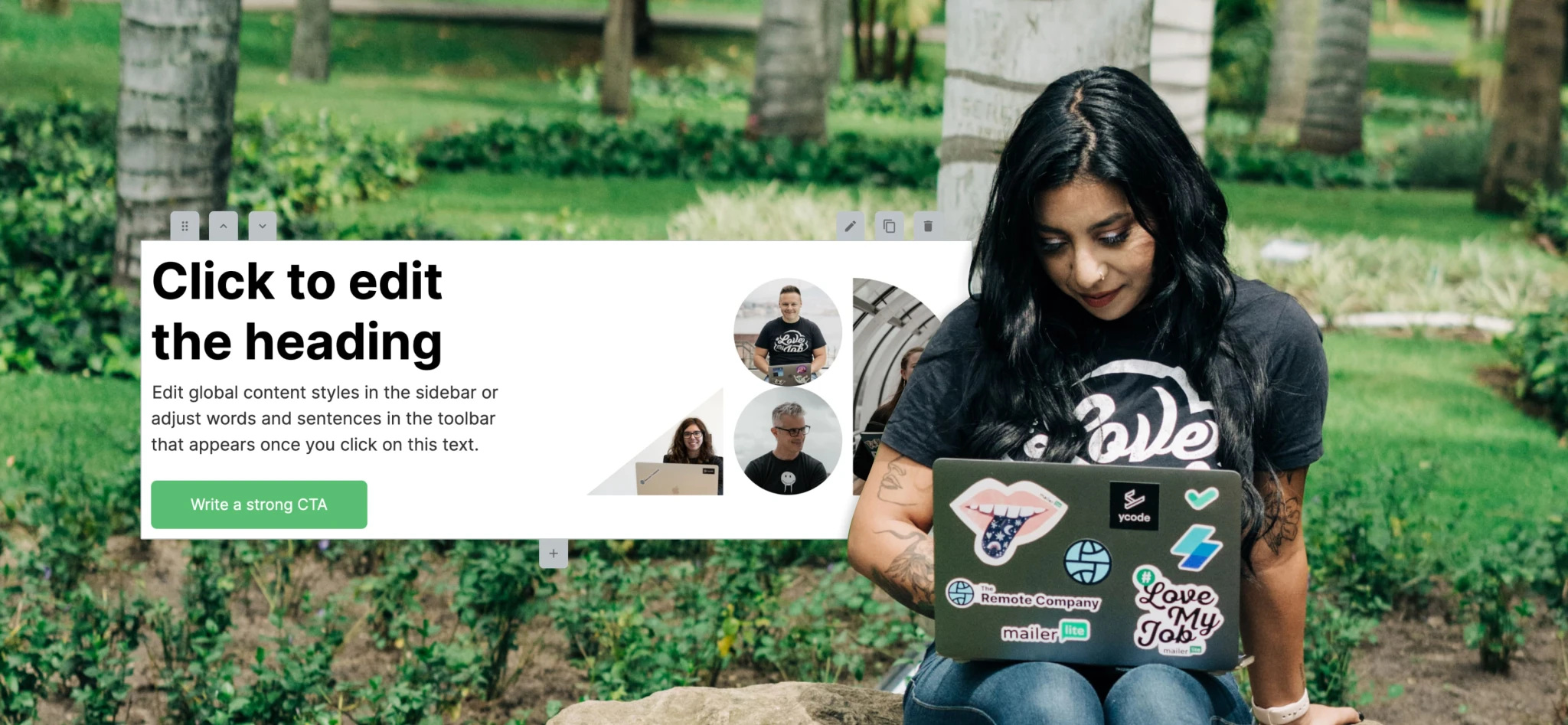 Harmony, Content Creator.
Harmony, Content Creator.
Managing resources efficiently is an essential part of running a business. So why spend big bucks on building a website if you don’t have to? A more cost-effective option is to choose a free website builder so you can design and publish your site without spending a cent.
The catch is getting all you need on a free plan. While plenty of website builders have a free option, each offers something different. No free plans give access to the entire platform.
But, if you prioritize the features you need, it is absolutely possible to create a beautiful site that shows off your business for free. Learn how with this guide to the best free website builders for small businesses. Read on to find out more or jump straight to the top tools list. 👇
How we evaluated the free website builders on this list
We’ve built many websites and these are tools we've used at one point or another. But, features change, so for this article, we dove back in and created a website with each service to see what makes them great.
All the tools on this list are excellent products, but some have specific features that stand out. We’ve highlighted these in the reviews.
We’ve focused specifically on the free plans and how they can help you build a small business website. Of course, you may choose to upgrade at some point, so we’ve also highlighted what the paid plans offer.
This article does not contain any affiliate links, nor did we receive any compensation from the tools ranked in this list. Just honest reviews of good products!
Website builder feature comparison table
 MailerLite
MailerLite
|
 Mmm.page
Mmm.page
|
|
 WordPress
WordPress
|
 Wix
Wix
|
 Carrd
Carrd
|
|
|---|---|---|---|---|---|---|
| Usability vs. customization | Balanced | Usability | Features | Features | Features | Usability |
| Bandwidth | Unlimitied | 1,000 visitors/mo | 2,000 visitors/mo | Unlimited | Up to 500MB | Unlimited |
| Forms | ||||||
| Storage | Unlimited | 40 blocks per page | 3 pages | 1GB | Up to 500MB | Image/GIF upload limit and block limit |
| Paid pricing | From $9/ month | From $4/mo | From $5/mo | From $4/mo | From $17/mo | From $9/year |
| Extras | Advanced email marketing | Digital canvas-style design | Build advanced sites and web apps | Powerful blogging tools | Community and membership features | One-page websites |
6 best free website builders for small businesses
Here is our list of the best free website builders for your business. We’ve highlighted the features of each tool and summarized what we like and dislike about one. Each listing also includes what you get when you upgrade to a paid plan, so you can see what you’re missing out on.
MailerLite: For feature-filled sites that are easy to build
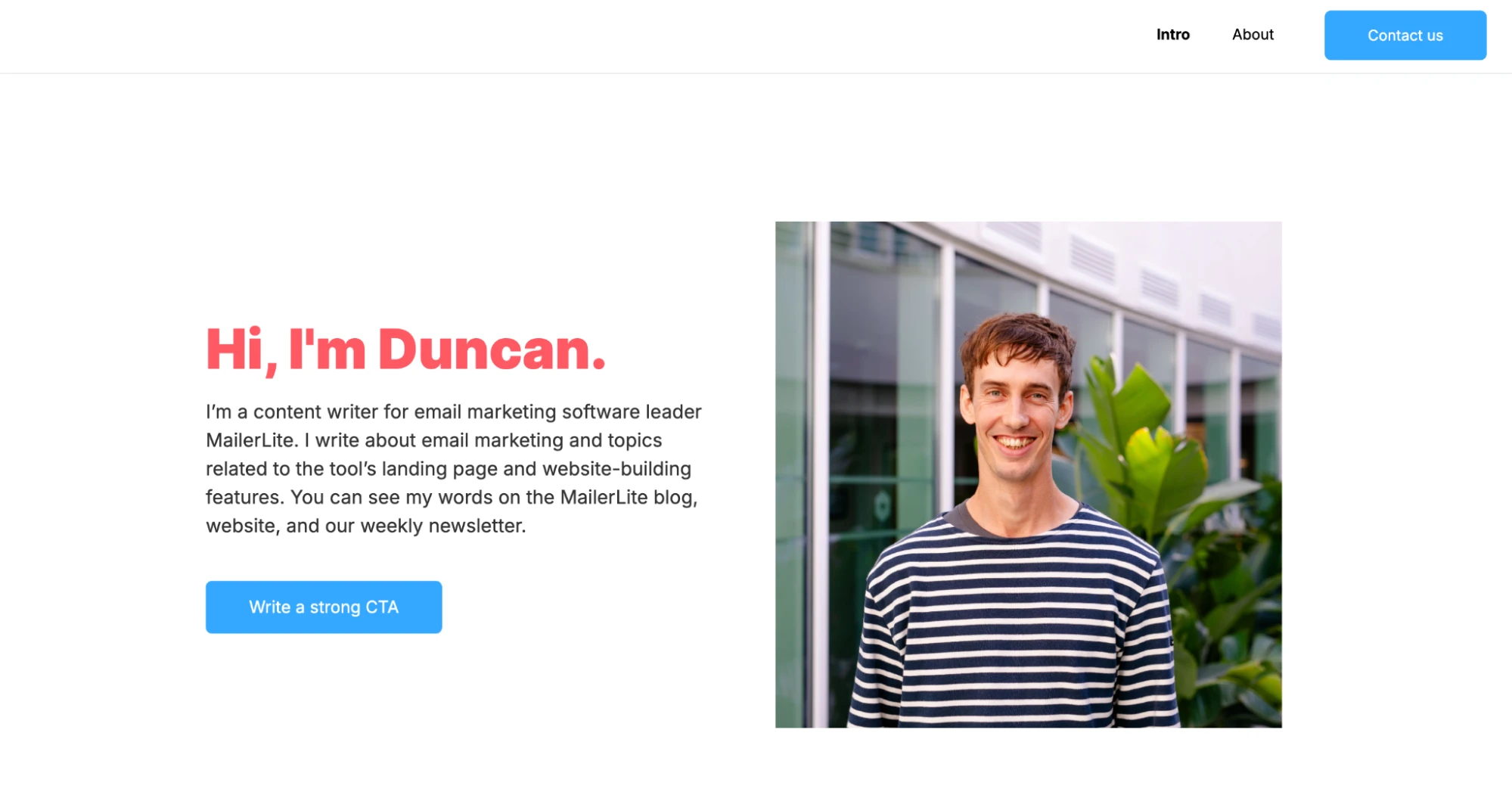
MailerLite helps you build a website that looks like it was created by a pro designer. The combination of templates, pre-built sections, and intuitive styling options make it a powerful yet easy-to-use solution.
The free plan lets you create a single website on a MailerLite domain. Access top features like forms, pop-ups, SEO tools, styles, and layouts. Plus, the website builder integrates with MailerLite’s email marketing features, to help you turn more website visitors into customers.
Pros
Very easy to build beautiful sites
Advanced tools like forms on free plan
Prebuilt blocks give your site a pro touch
Plenty of customization options
Create and reuse styles
Built-in email marketing
Easy-to-use SEO and social sharing features
Cons
Templates require paid plan after first month
Blog feature requires paid plan
E-commerce blocks require paid plan
Setting up a website with MailerLite is easy
Setting up your site with MailerLite takes just a couple of clicks. When starting, you’ll be prompted to give your site a name and choose to create either a landing page or an entire website.
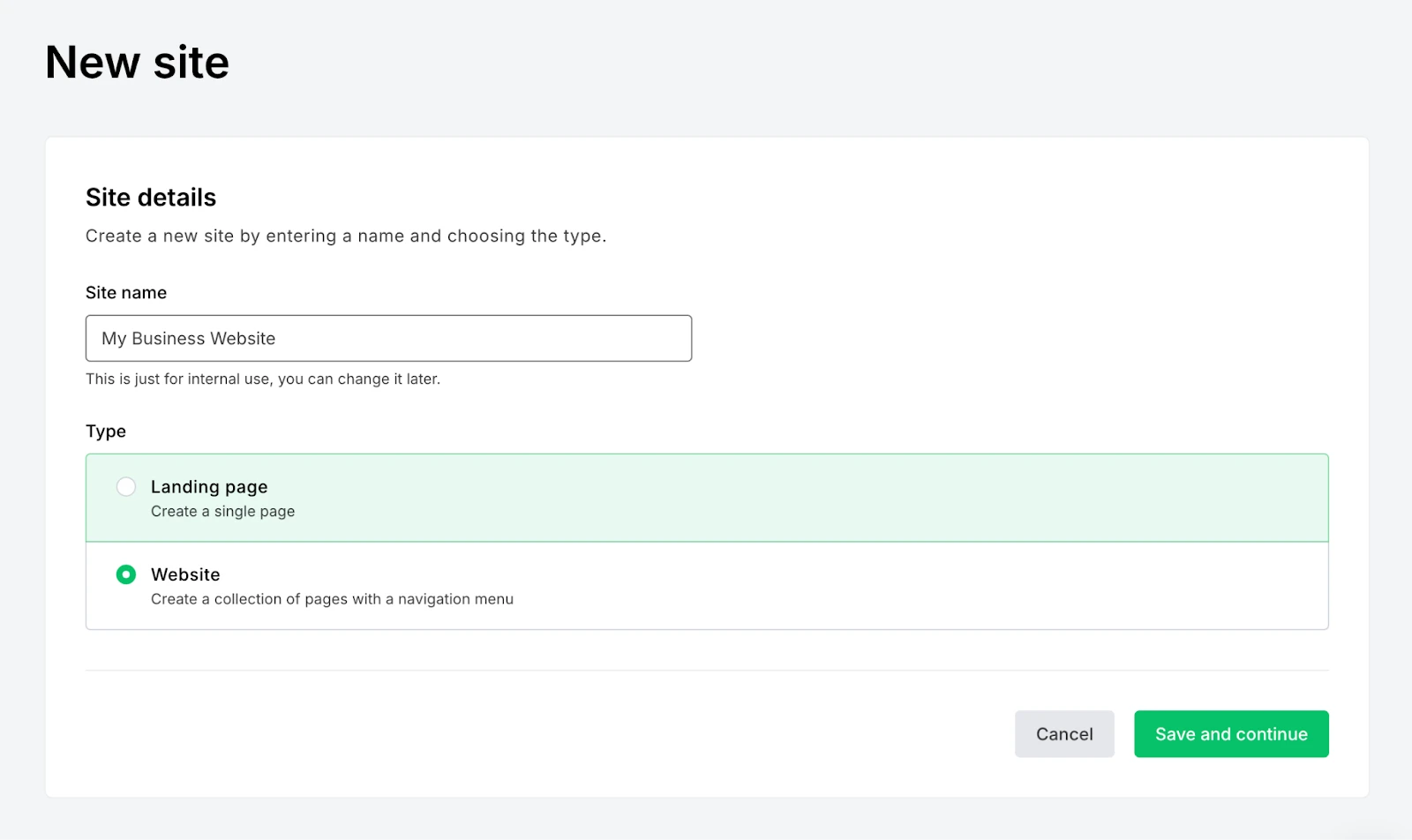
You then have to choose a subscriber group. Anyone who submits their email address via a form on the website will be added to your chosen group.
If you don’t have any groups yet or don’t plan to set up email marketing, create a group with your website name. This won’t impact your site until you decide to add email signup forms, at which point the process of collecting email addresses will be super streamlined.
Access plenty of features to create a beautiful design
When setting up your site, start from scratch or use one of the existing templates. Browse the templates to see if one catches your eye, there are plenty of options in different styles.
Don’t worry too much about the actual template content, you can easily edit it in the next step. We had a specific idea in mind so we chose the option to start from scratch.
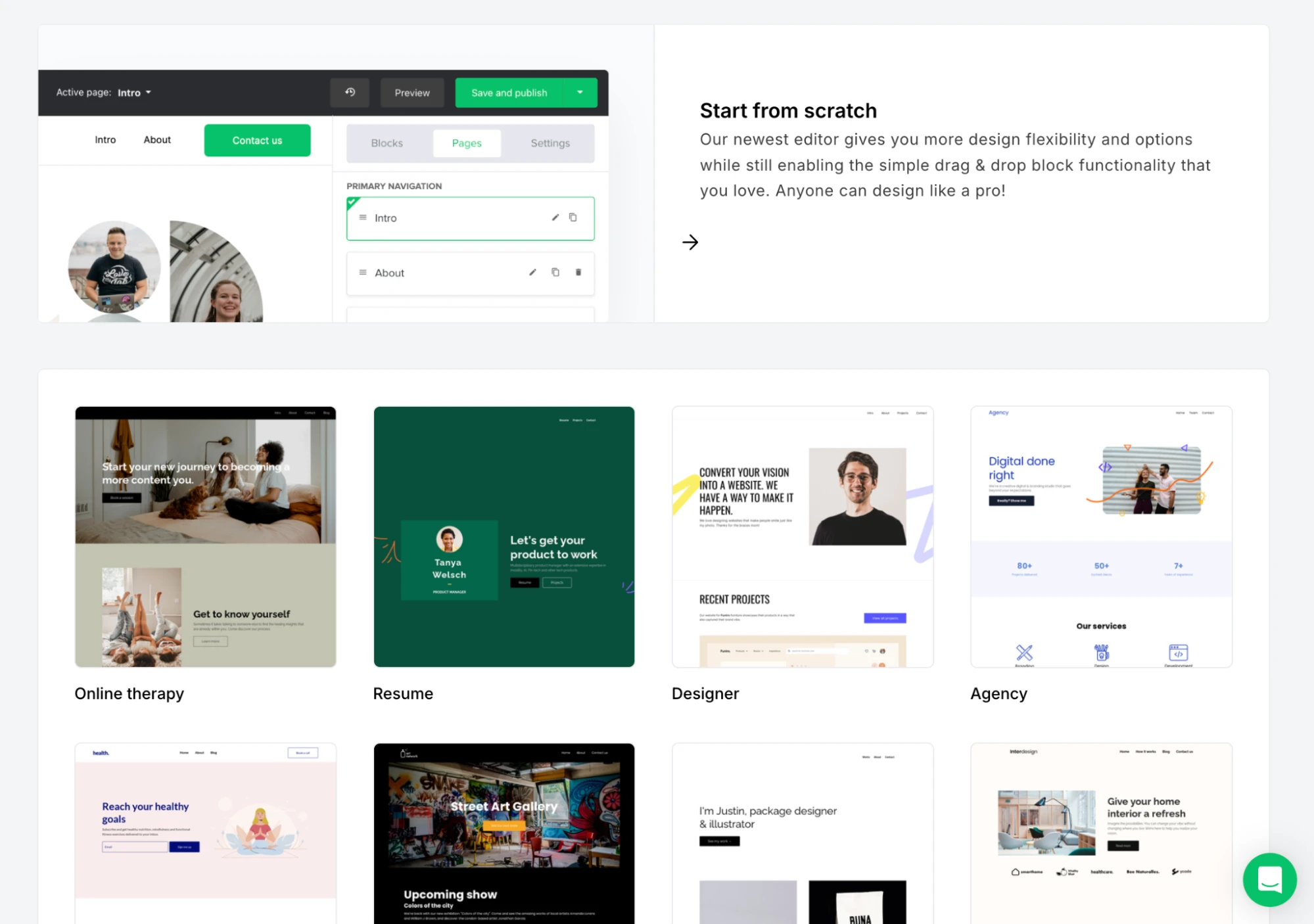
Templates aren’t technically available on the free plan. But, when you first sign up you’ll start a free trial of advanced features. If you choose a template during this time, you can keep using it when the trial ends.
The highlight of the builder is the pre-made blocks that you can drag onto the page and customize. Since these blocks are built with design best practices in mind, you’re almost guaranteed that the end result will look good.
There are tons of blocks, including those for:
Text
Images
Signup forms
Contact forms
Testimonials
Galleries
CTAs
Content columns
Surveys
Quizzes
Accordions
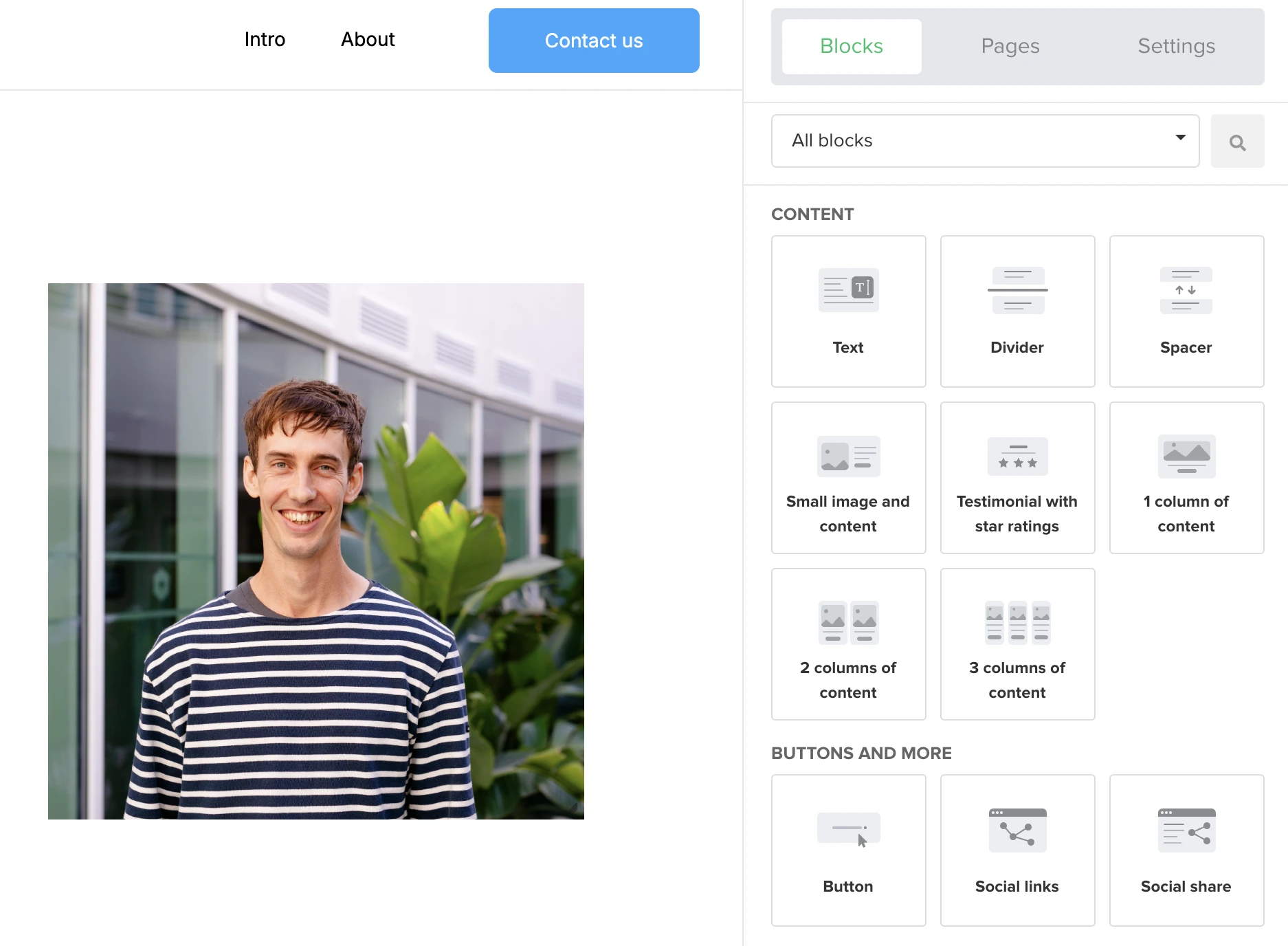
Each block has plenty of customization options, such as the ability to change colors, fonts and even the spacing of the page.
You can also start with an empty column and simply add the individual elements you need. This gives you a ton of design freedom, so let your imagination run wild.
The styles tool is another highlight. This lets you add your own brand colors and fonts in different page elements, such as headings, text, backgrounds, and forms.
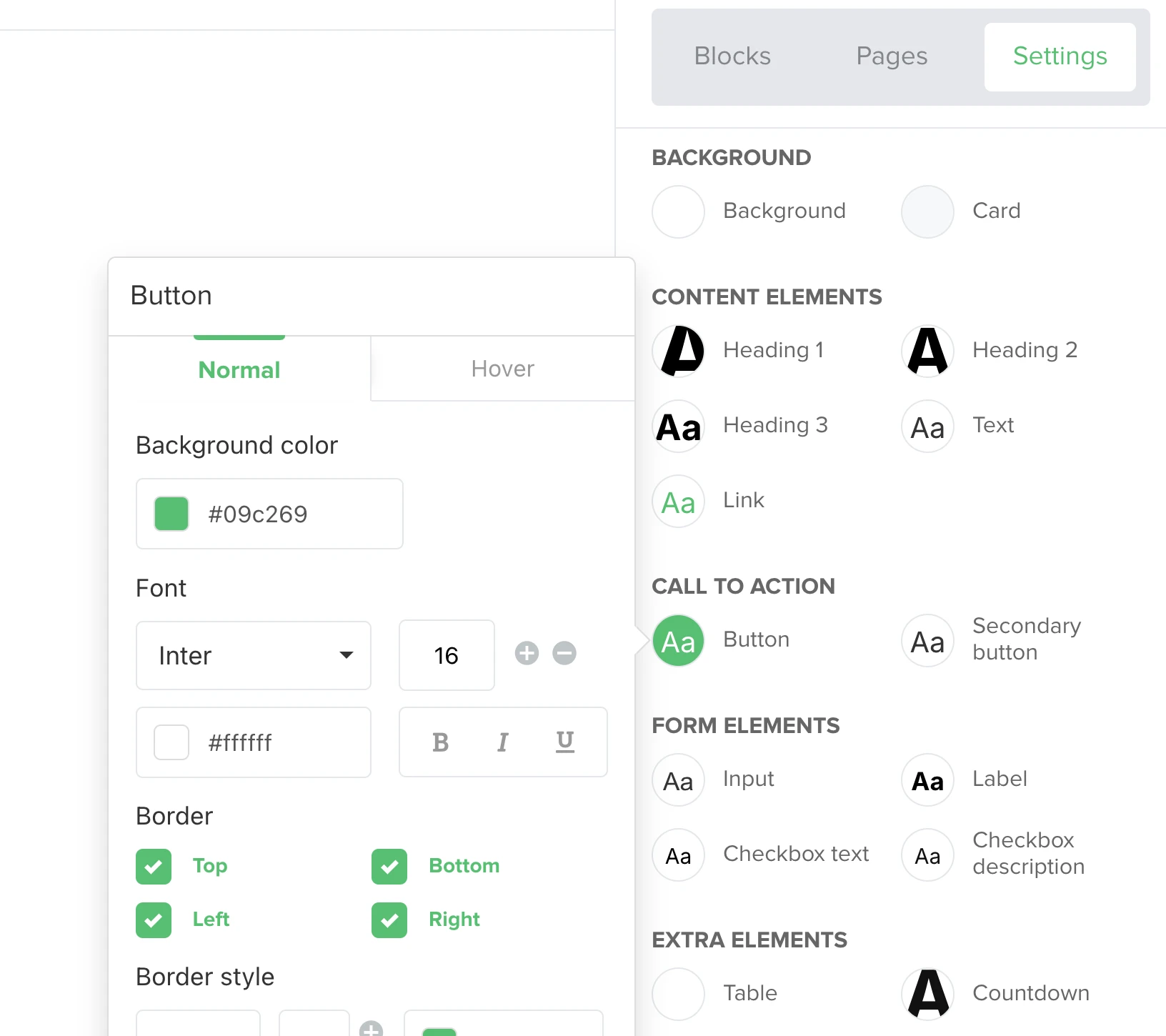
You’ll save a ton of time as you won’t have to edit styles every time you add a block to your website.
Built-in email marketing makes converting visitors a breeze
MailerLite is primarily an email marketing tool. The website builder’s close email marketing integration is a huge selling point for small businesses.
It’s easy to add pop-ups and forms to the website which you can use to grow your email list or trigger email automations. Choose the form block and then customize the fields, design, and success message.
Forms are available on MailerLite’s free plan, which isn’t the case for some of the other tools on this list. If you want to collect leads on your business website, MailerLite is a great option.
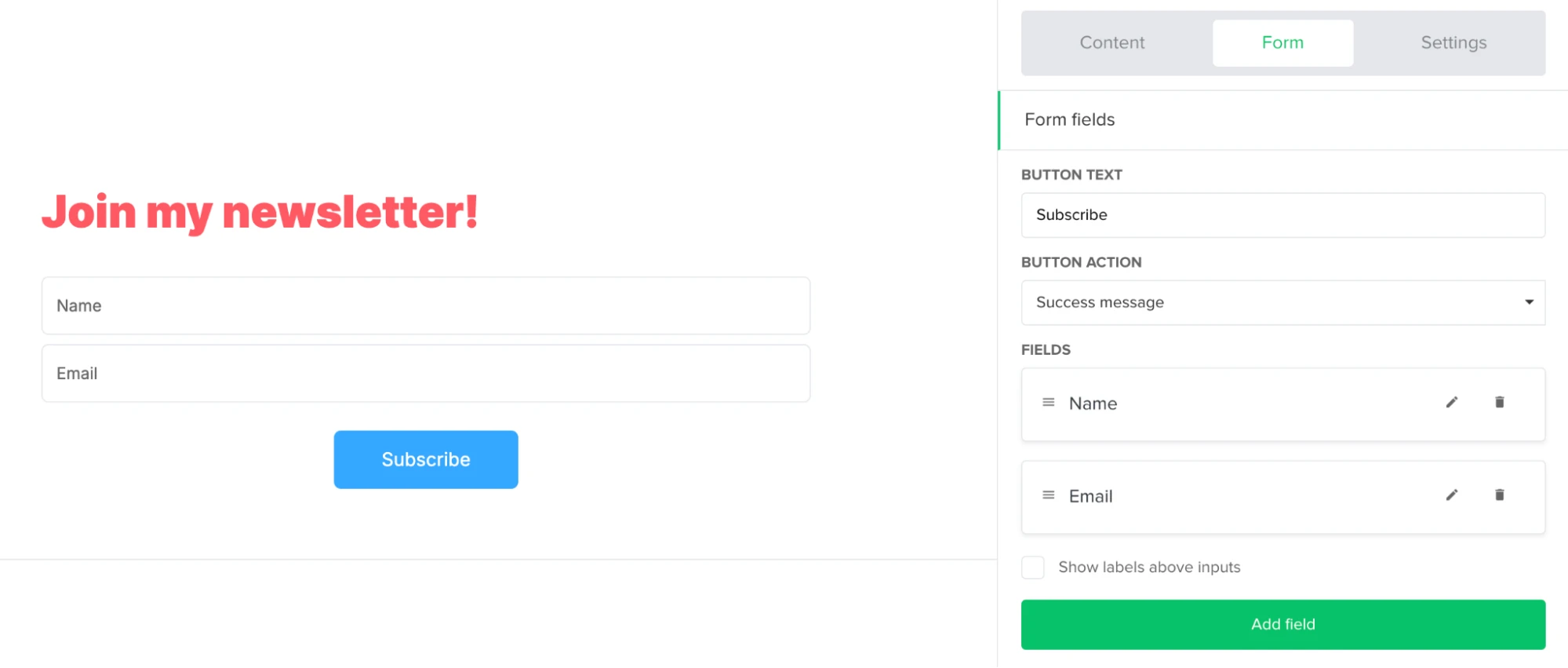
Use these forms to collect leads and send newsletters updating them about your business or nurturing them toward a sale. Or, create an automation so that people receive an email the moment they fill out a form.
You can even create different automations for different forms. Here are some ways that could be useful:
Event page: Send relevant information to remind people and help them prepare
Lead magnet page: Deliver the lead magnet and then more relevant content and offers
Waitlist: Provide product updates as it gets closer to release
Discount or offer: Deliver the offer and send reminders
There are so many things that you can do with email marketing and a website, the exact strategies you implement will depend on your business.
Should you upgrade to a paid plan?
MailerLite’s free plan gives access to the majority of its website-building features. It’s possible to create a great website without paying.
If you choose to upgrade, the $9-a-month Growing Business plan lets you connect your domain and gives access to templates and e-commerce features. The $18-per-month Advanced plan unlocks custom code and password-protected pages.
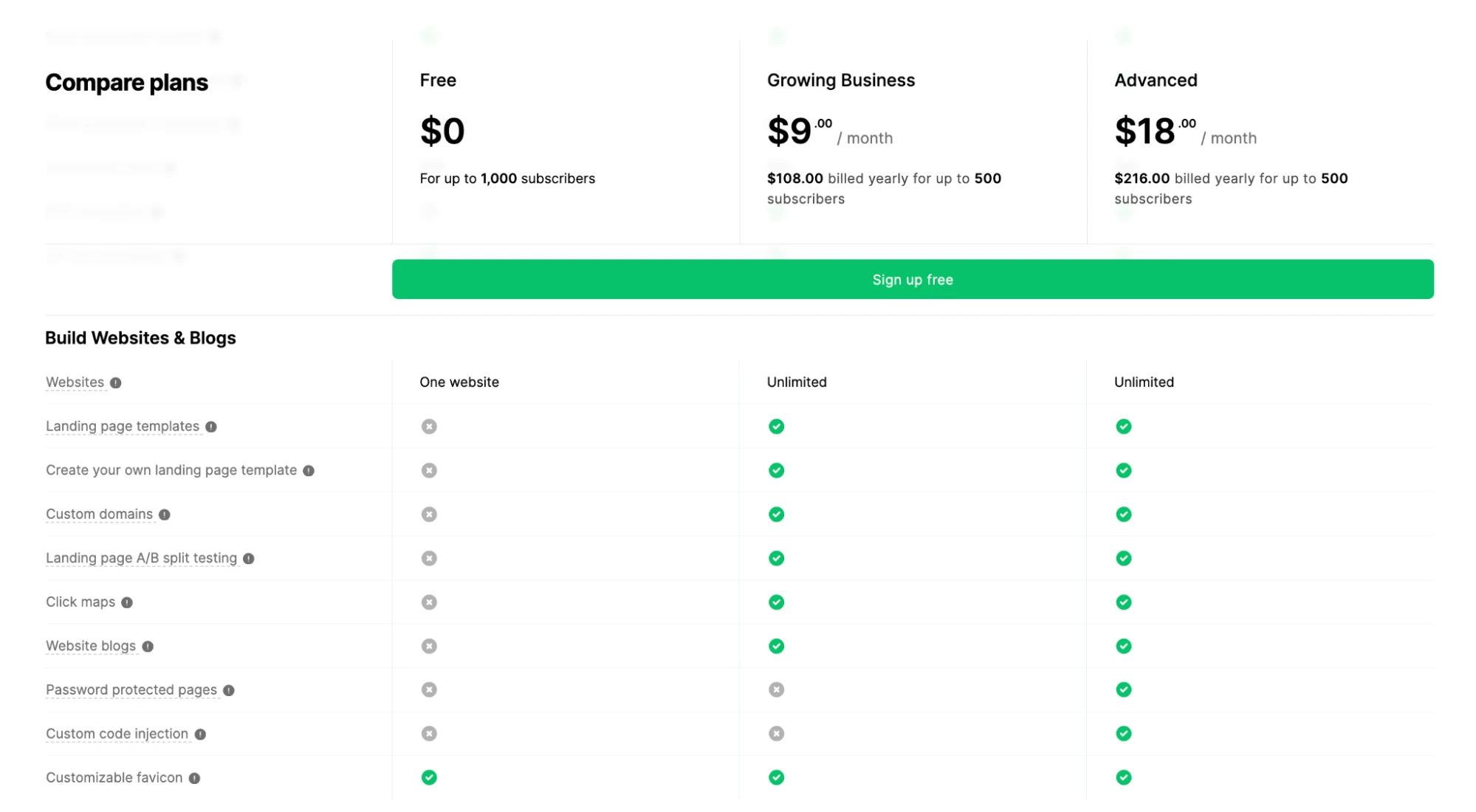
The free plan also comes with the ability to store 500 contacts and send 12,000 monthly emails. If you want to increase these limits, you’ll need a paid plan. The exact price you pay depends on the number of contacts you have.
Build a free business website with MailerLite
Grow your business with a beautiful website. Showcase your brand, collect leads, and implement powerful email marketing with intuitive visual tools. Try it today.
Wix: Complete design flexibility, with one major issue
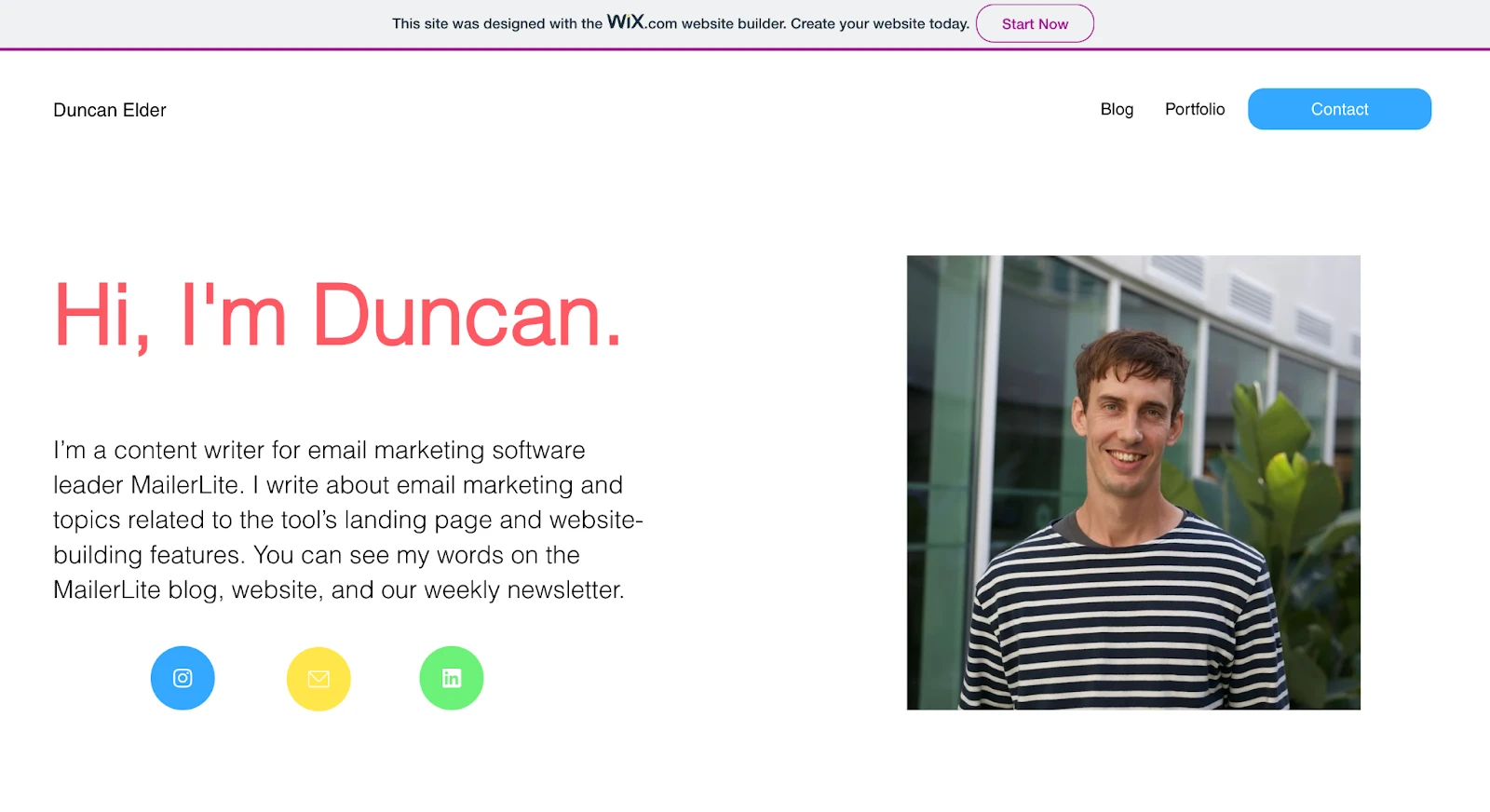
Wix is a powerful visual website builder that lets you drag and drop elements anywhere on the page. This makes it easy to create pretty much any website design you want. The free plan is also generous and gives access to all the main Wix features except the ability to accept payments.
The big issue with the free plan is that all free sites come with intrusive Wix branding. This will be a big turn-off for many small business entrepreneurs. Having said that, if you want complete design flexibility for free, Wix is a great option.
Pros
True drag-and-drop interface
Powerful form builder
Tons of templates
Access to most features on the free plan
Comprehensive brand styling options
Form builder with loads of options
Easy-to-use responsive design tool
Cons
Intrusive Wix branding
AI tools were hit-and-miss
E-commerce features require a paid plan
Getting set up: Hit-or-miss AI
When you go to create your site, you get the option to use Wix’s AI chatbot tool. This wasn’t available the last time we built a site on Wix, so we were keen to try it out.
The bot asks questions about your site and uses your answers to set up your dashboard. Later, it uses this information and other preferences to create an entire site with AI.
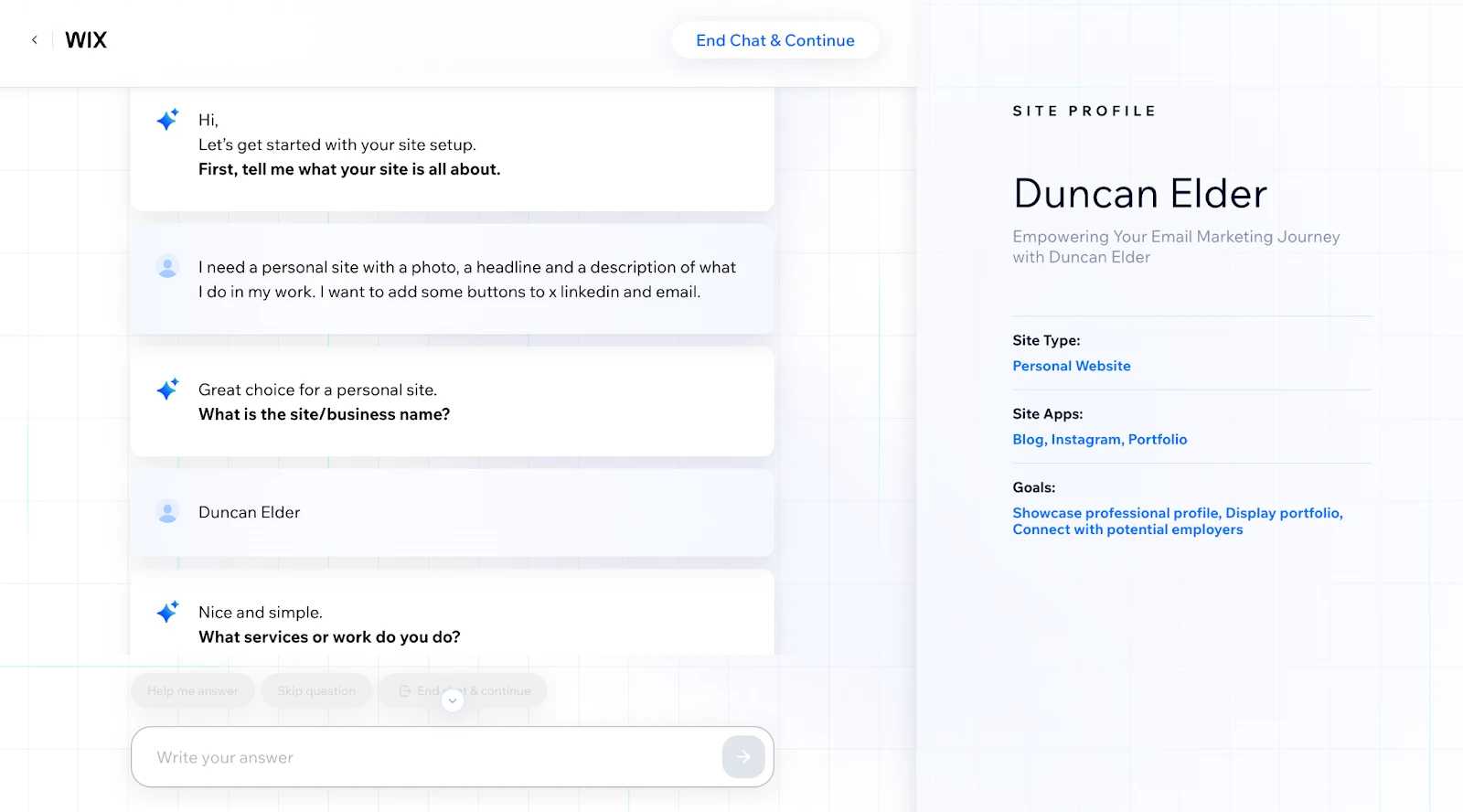
Unfortunately, the sites Wix generated weren’t what we wanted. They didn’t use the colors or buttons we suggested.
Having said that, the design isn’t too bad. It would probably work as a simple template if you were more flexible with what you wanted. Plus, you can hit refresh until you find a design you like.
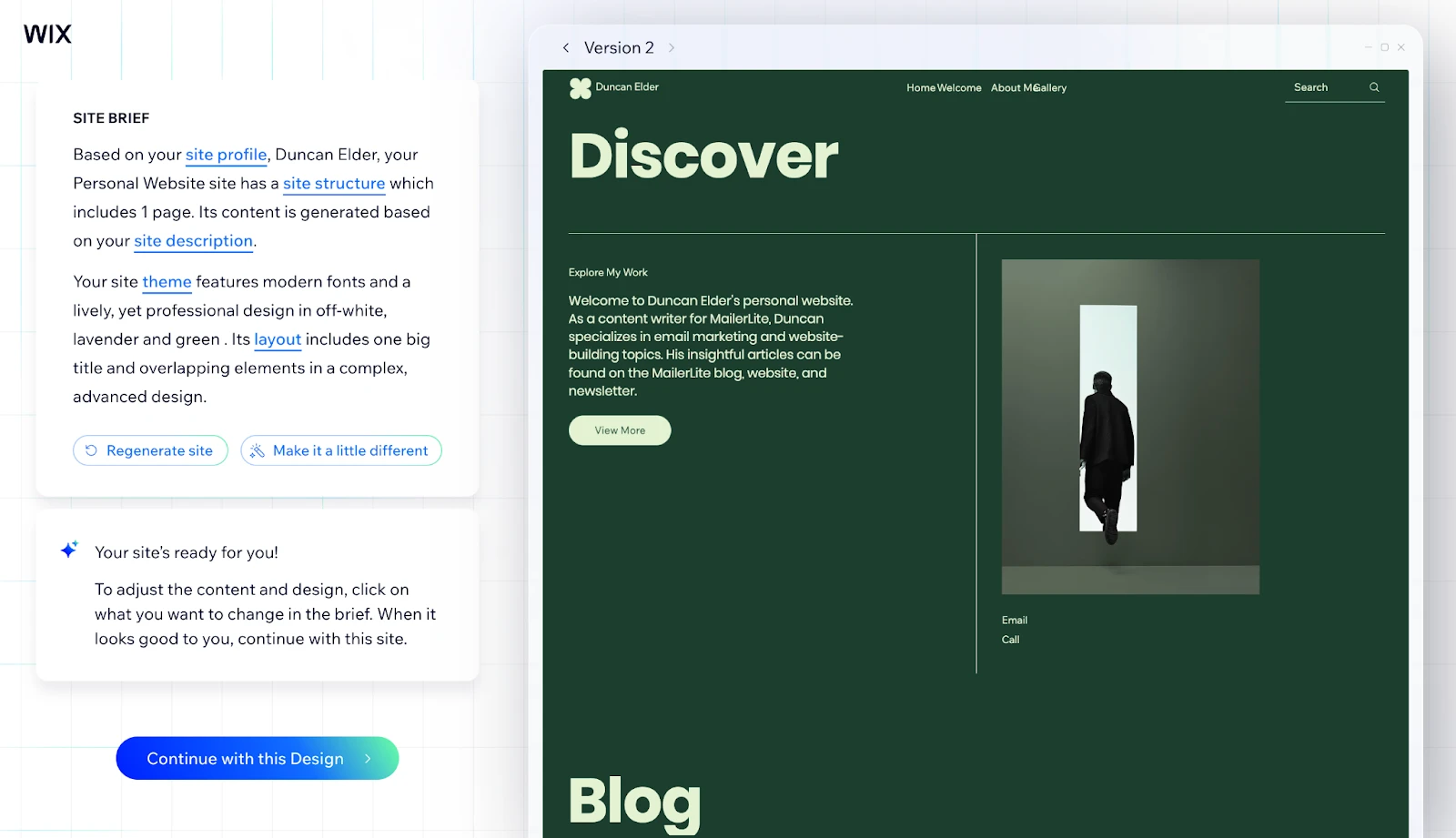
After this experiment, we decided to try the original way of building a site: Using templates. Wix has plenty of site designs in tons of categories that you can choose from.
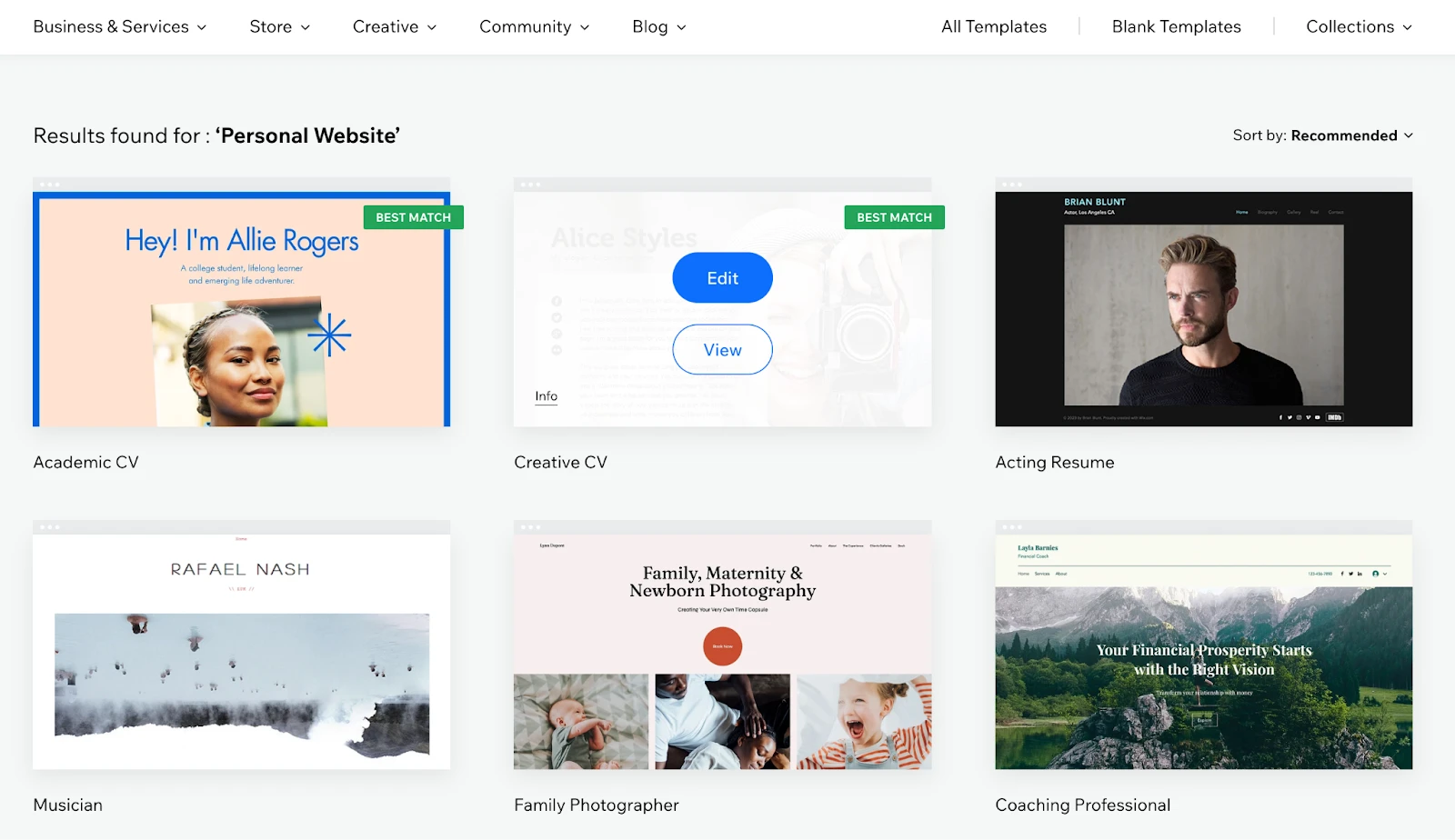
Once you’ve chosen a template, editing the elements is easy. Click on the section you want to change and start customizing. You get plenty of options to change settings like the font and spacing or add animated effects.
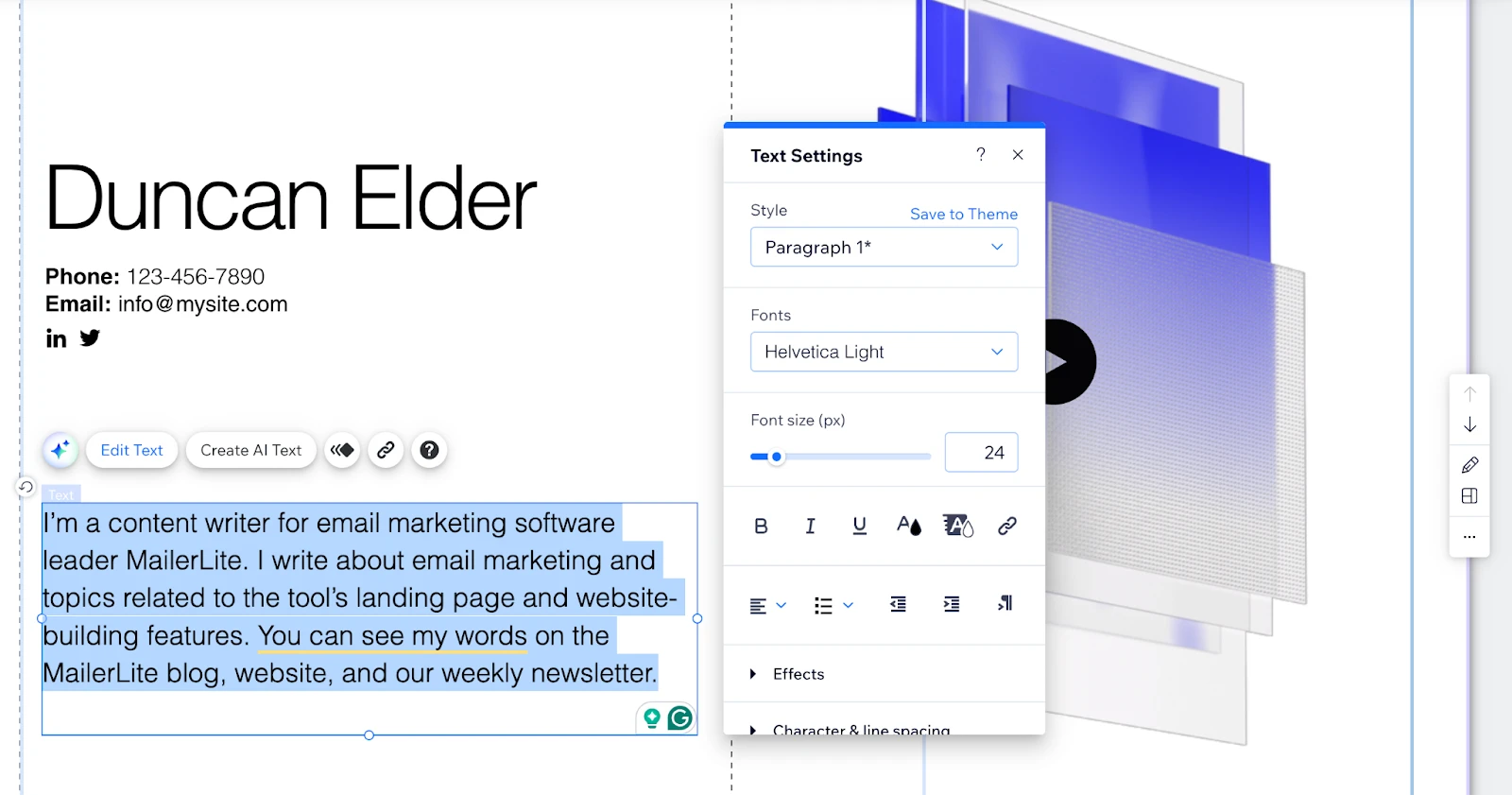
The editor has plenty of blocks you can use to add anything from images and videos to custom code, decorative graphics, product blocks, signup forms, and more.
Once you’ve chosen a block, you can drag it anywhere on the page, giving you real design freedom.
While this could be overwhelming, especially if you’re not a designer, Wix automatically shows spacing recommendations to help you choose the best place for each element.
This method of web design is not as easy as pre-built blocks and you may have to spend time experimenting with the design. But it gives you much more design freedom. You just have to think about what’s more important for you.
Intuitive, responsive design options
One worry we had about the design freedom was how it would impact the responsiveness of the site. If you have individual elements all over the page, how will Wix know how to order these items on mobile devices?
The landing page builder has a good solution. It automatically takes your design and creates a layout it thinks would work on mobile. Wix also asks some quick questions and uses the answers to tailor the design to your needs.
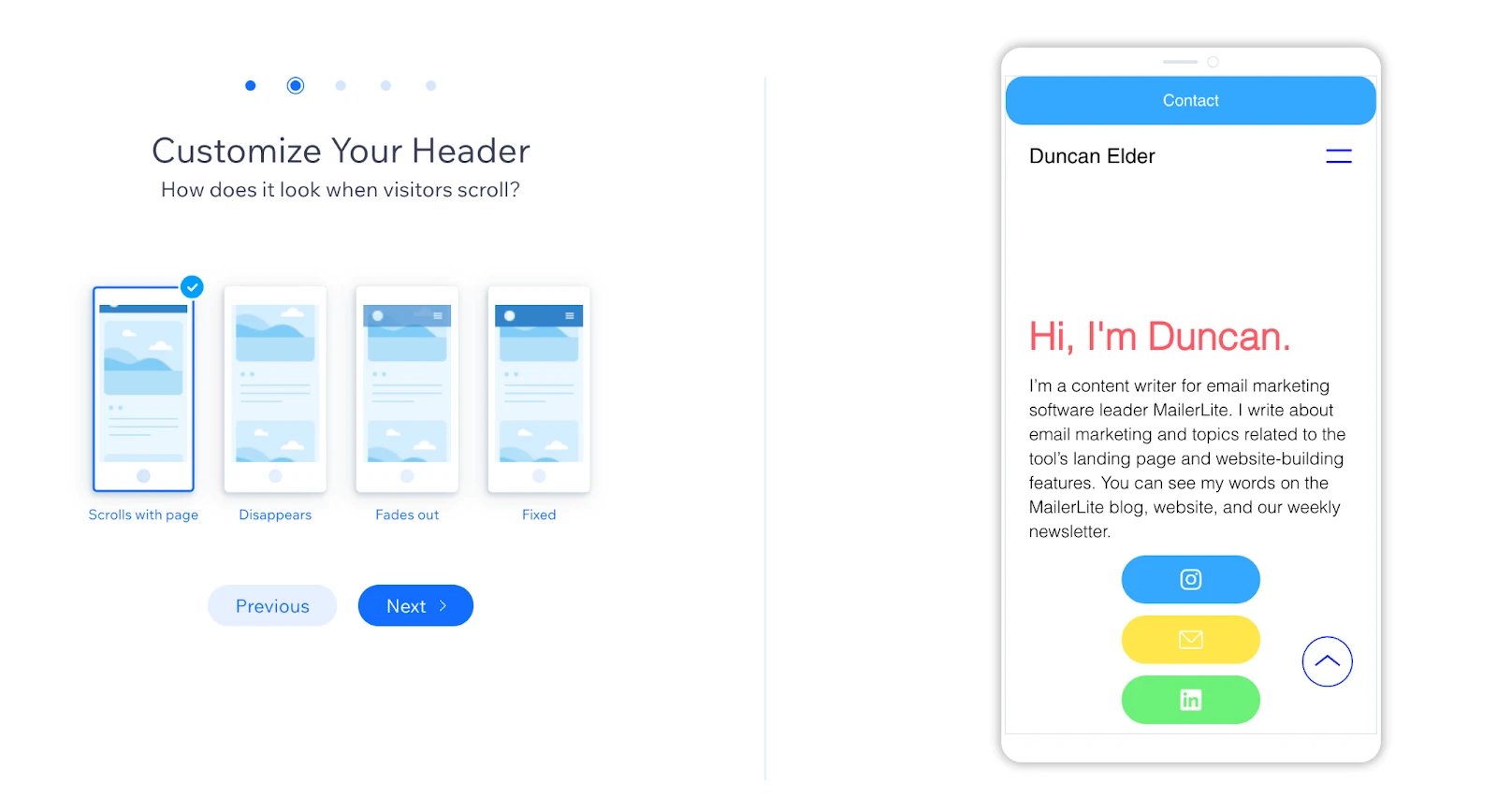
If you’re not happy with Wix’s automatic design choices, you can drag and drop the elements into an order that makes sense for you. Don’t worry, none of the changes you make to the mobile view will be reflected on desktop browsers.
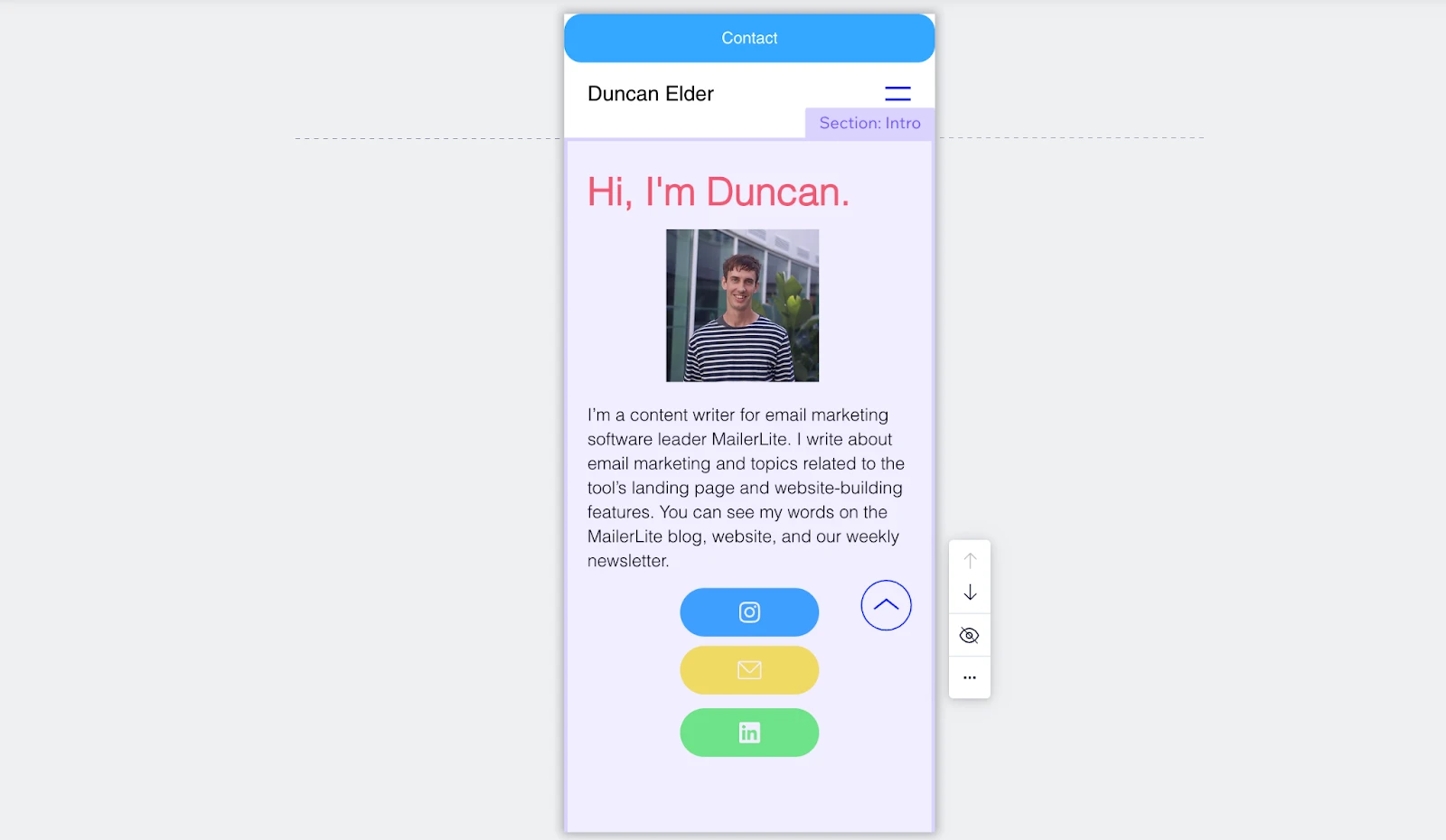
We found this to be a simple solution to a potentially complex problem. And we were happy with the result.
Comprehensive brand styling options
Brand styles make it easy to create a consistent website design. In Wix, you can easily set the font, color and stylings to use for headings and paragraph text. Then just choose the style to attribute to each element on a page.
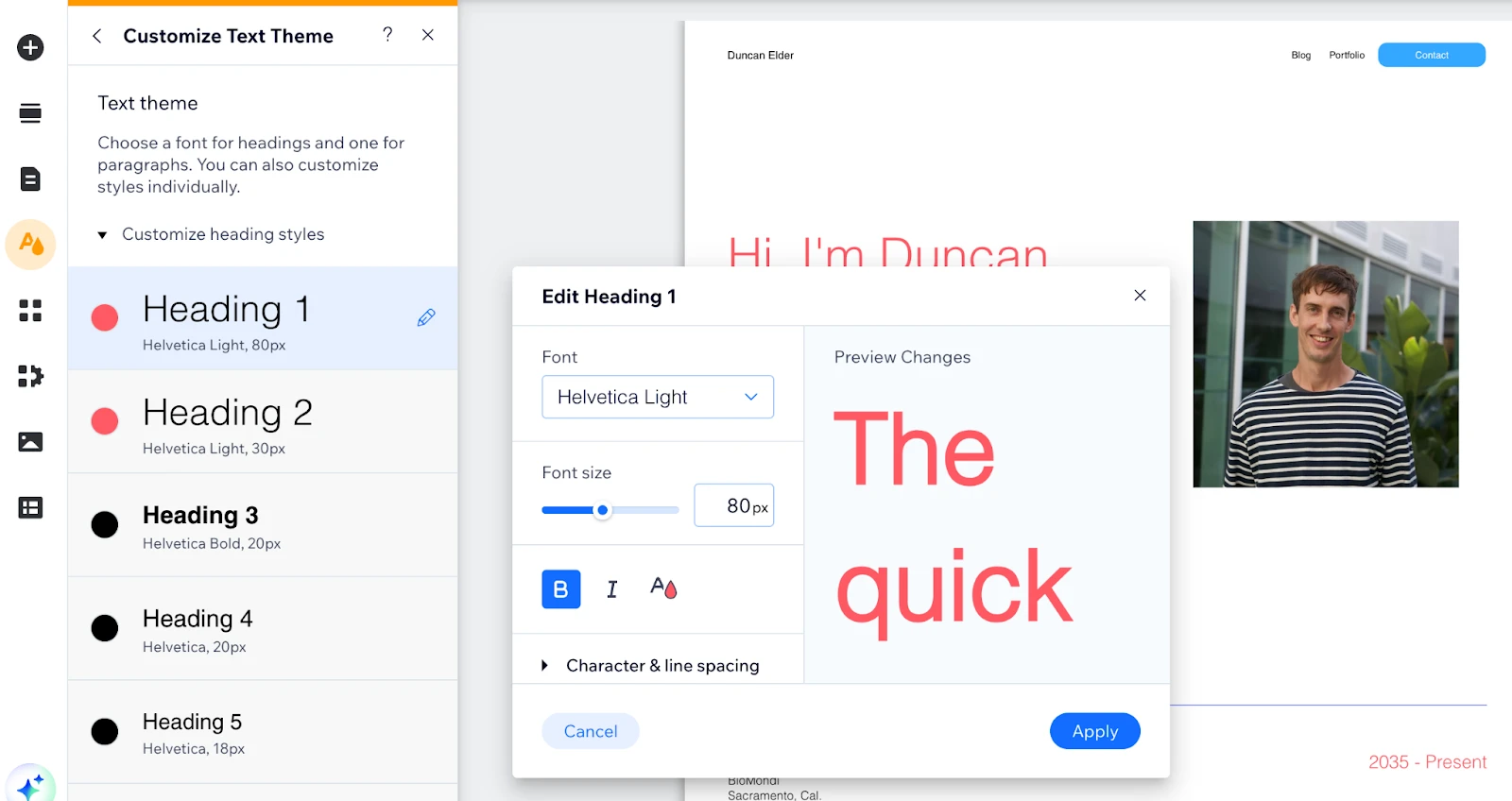
When you make a change to a style, it’s reflected instantly across any element already on your site. This lets you make wholesale changes without having to adjust each element individually.
And you can add your brand colors to the options so it’s easy to choose the right color when editing elements in your design.
Full-featured form builder
The form builder is also useful. You get the same design options as with the rest of the Wix builder so you can create a design that’s unique to your site.
It’s also easy to add advanced form features like multiple fields and different answer types to your forms.
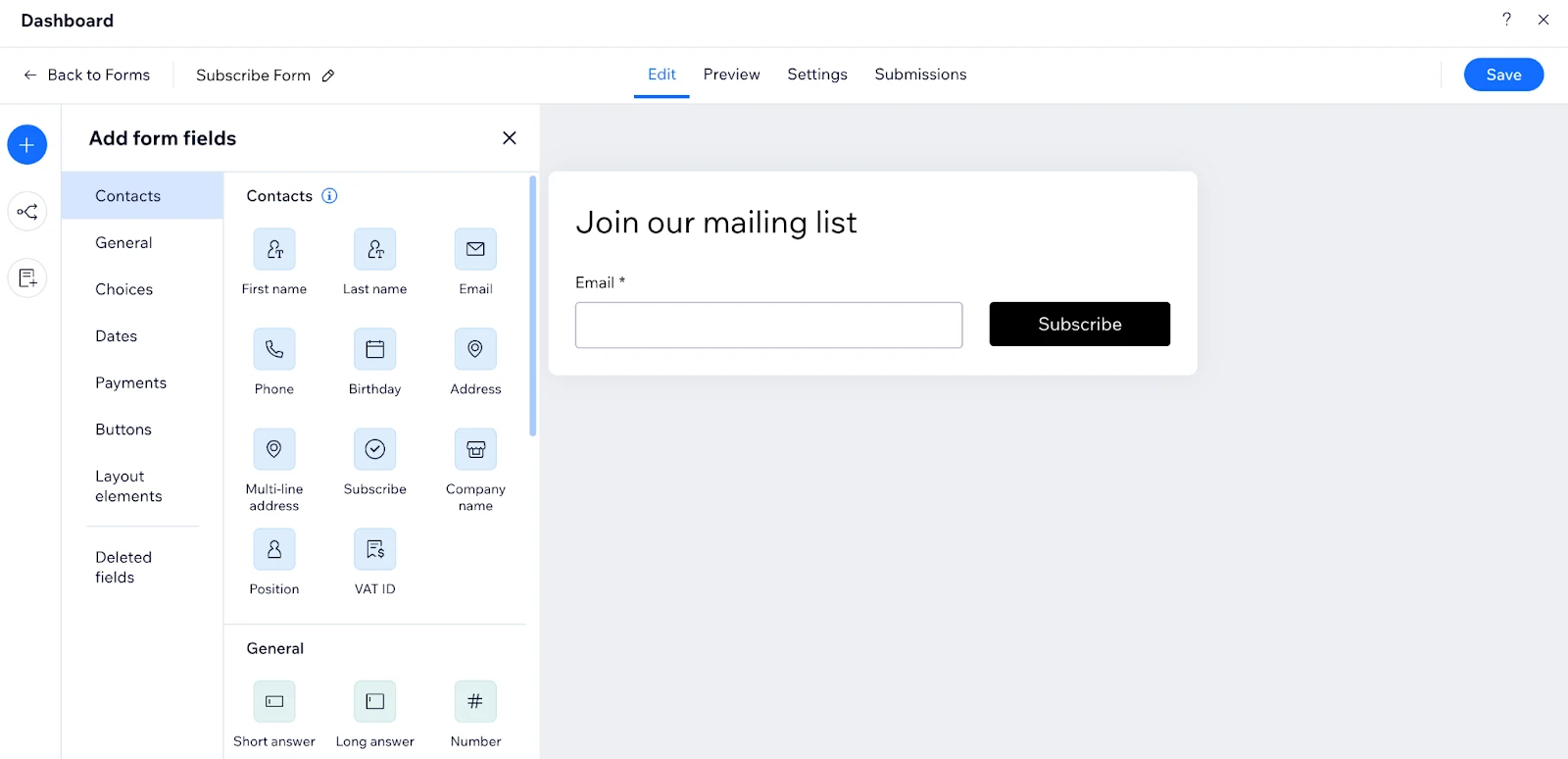
Plus, if you ever upgrade to a paid plan, you can use the MailerLite and Wix integration to automatically add people who join your email list via a form to your subscriber list in your ESP.
Should you upgrade?
Wix’s free plan has one big issue: All free sites have a large banner saying that the site was designed by Wix. The ad also has a call to action asking the visitor to create their own site.
This will be a dealbreaker for many: The prominent banner simply looks too unprofessional to use on a business website. The last thing you want when people visit your brand is for them to be distracted by another site.
To remove Wix branding, you’ll need one of the four paid plans which range from $17 to $159 per month. The cheapest plan will be enough for many small businesses who need a simple site. Those who want to create an online store will need the Core plan or higher.
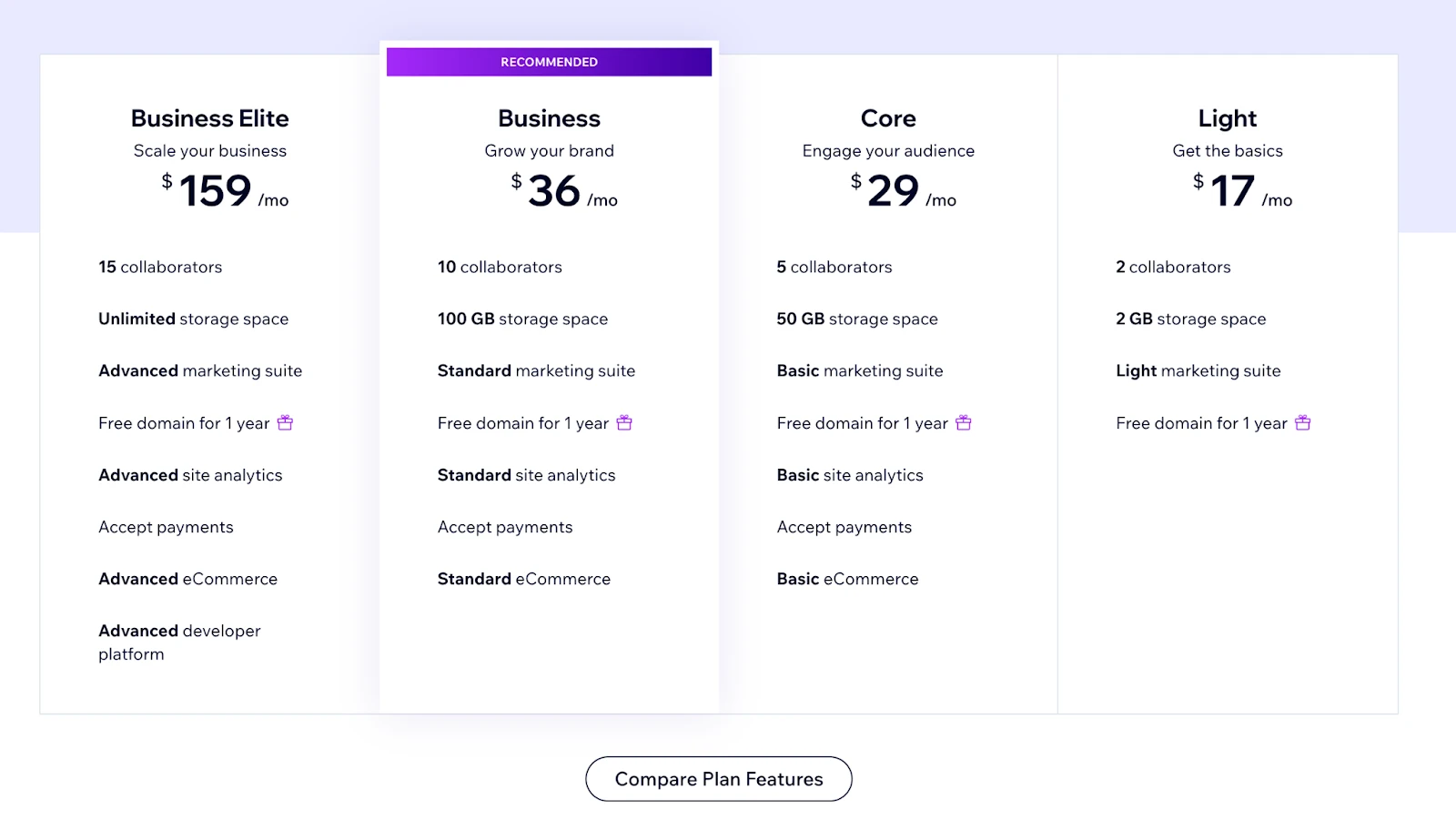
WordPress.com: For small business owners with big plans
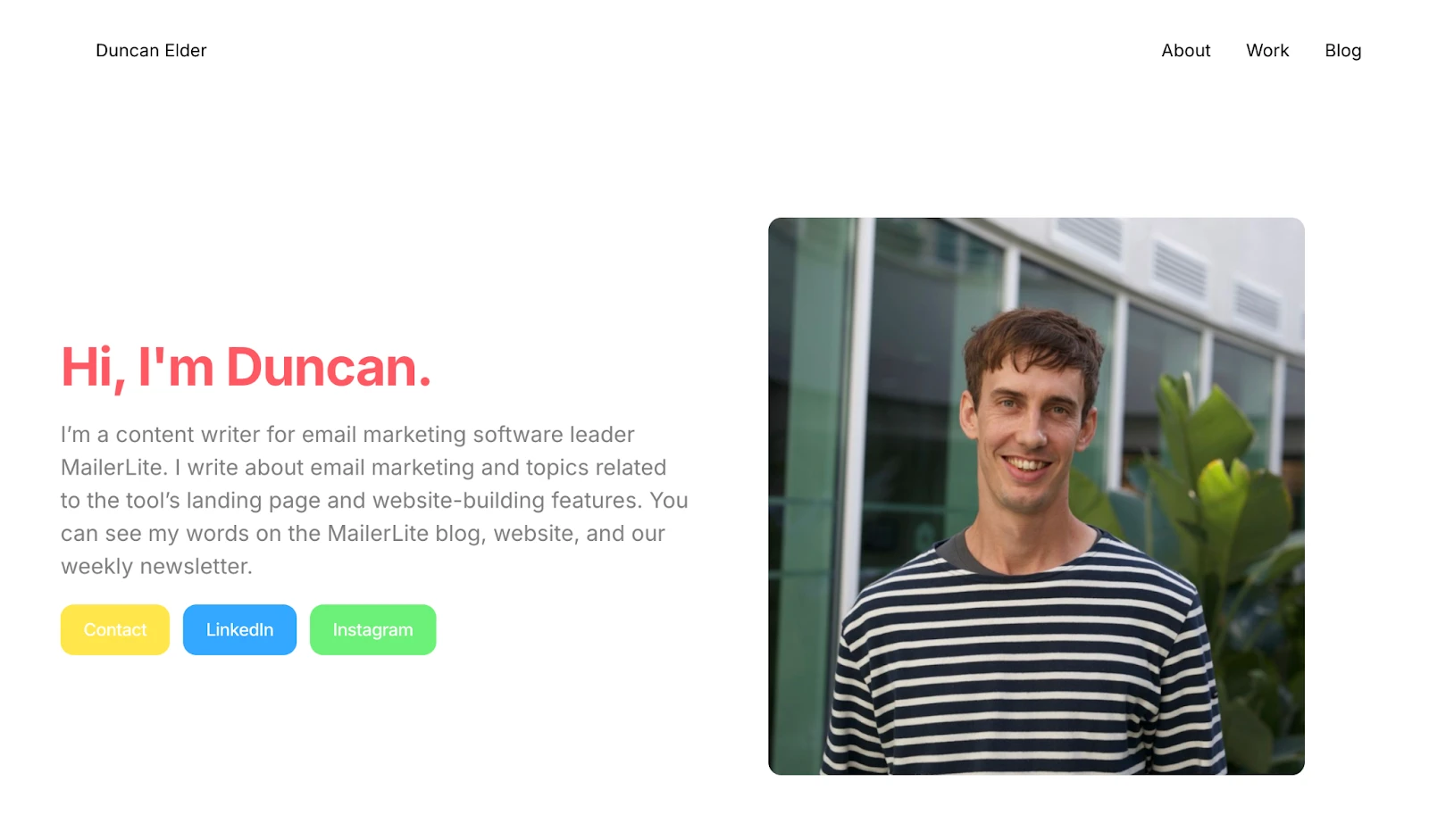
WordPress.com is an easy way to create a site with the open-source content management system WordPress. It has a free plan that lets you create a website with the basic WordPress features.
In many ways, the tool is hard to recommend as a free website builder. It’s got a steep learning curve and lacks many features offered by other tools. But, if you plan to start with a free, simple website and then build it into something more complex, WordPress is a great option.
Paid plans give access to WordPress plugins, which enable you to create pretty much any website you want (there’s a reason why 43.5% of websites use WordPress).
The only question is, is it worth it for your small business? There are plenty of other web builders that allow you to create complex multi-page websites with a much more intuitive user experience.
Pros
Proven CMS used by millions of sites
Powerful blog functionality
Plenty of help resources and tutorials
Tons of free website templates
Access to plugins if you upgrade
Cons
Hard to use
Limited design options on free plan
Need paid plan to access most features
WordPress is open-source, free-to-use software that you can download from WordPress.org. WordPress.com is a service that makes it easy to set up WordPress websites.
Instead of using WordPress.com, you could buy your own web hosting from a service like GoDaddy or Siteground and set up WordPress on your own. This can be a cheaper way to access WordPress, although it’s not quite as user-friendly as using WordPress.com.
Sign-up is easy, if you can find it!
The hardest part of signing up for a WordPress free plan is that the company has hidden the option from its pricing page. We had to search on Google to find it.
Once you’ve found the free plan page, things get easier. From the dashboard, choose to create a site, select a domain name, and tell the company what you want to use your website for so it can provide relevant templates.
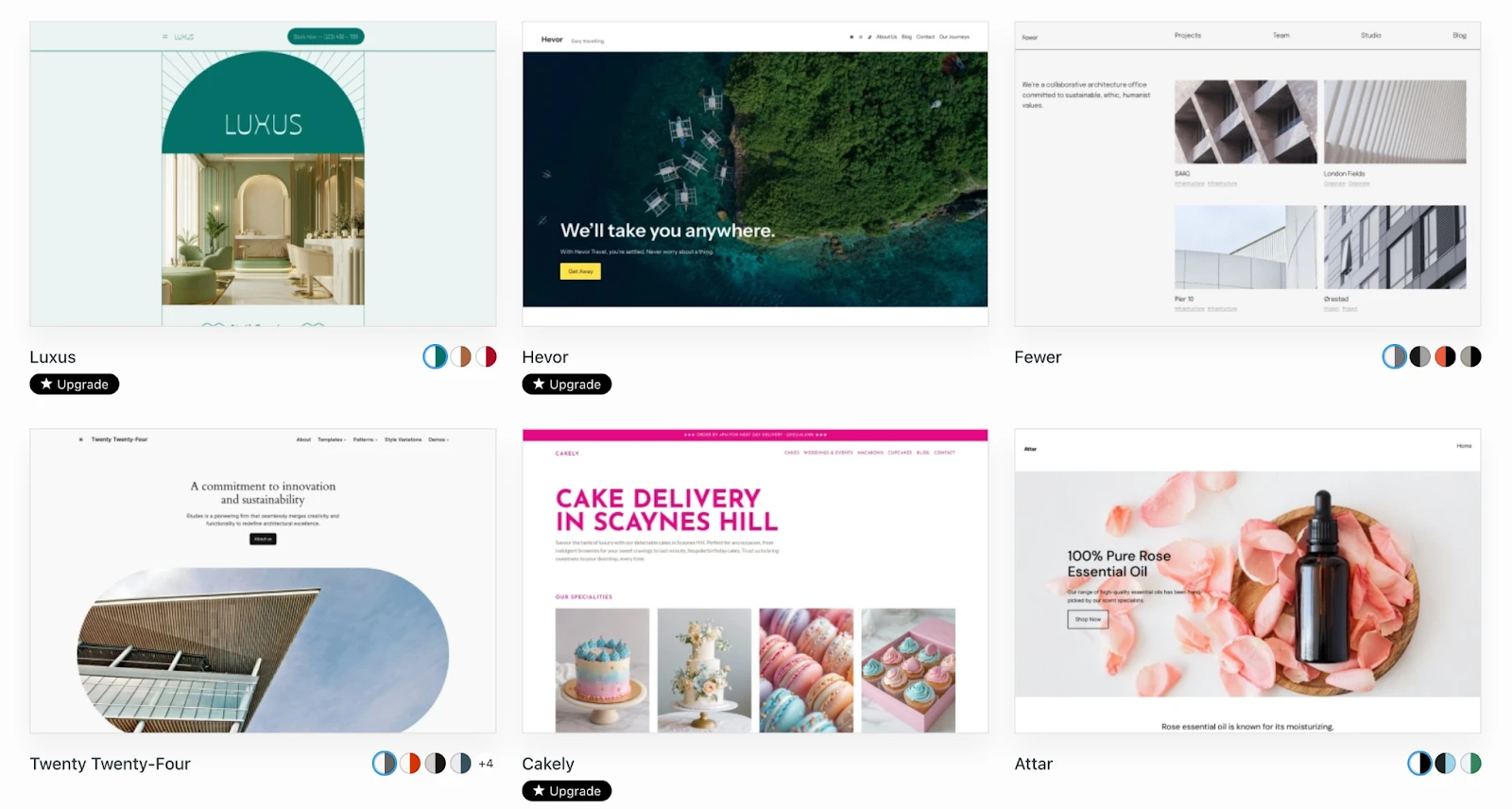
You’ll notice that many of the best themes are paid, but there are still plenty you can use for free. You’ll then get the option to fill out key details before building your site.
Designing your site with blocks and patterns
The basic WordPress designer has improved a lot in recent years. It’s possible to create beautiful sites without plugins, which boosts the value of the free WordPress plan since it doesn’t allow you to use them.
Editing the design you choose is also easy. Simply edit the text on the page, swap images, or change fonts and colors in the side panel.

The editor uses blocks that you can connect together to create an impressive variety of designs. Start by choosing a group and then placing the elements within this group. You can also choose from pre-built patterns and then edit them to your business needs.
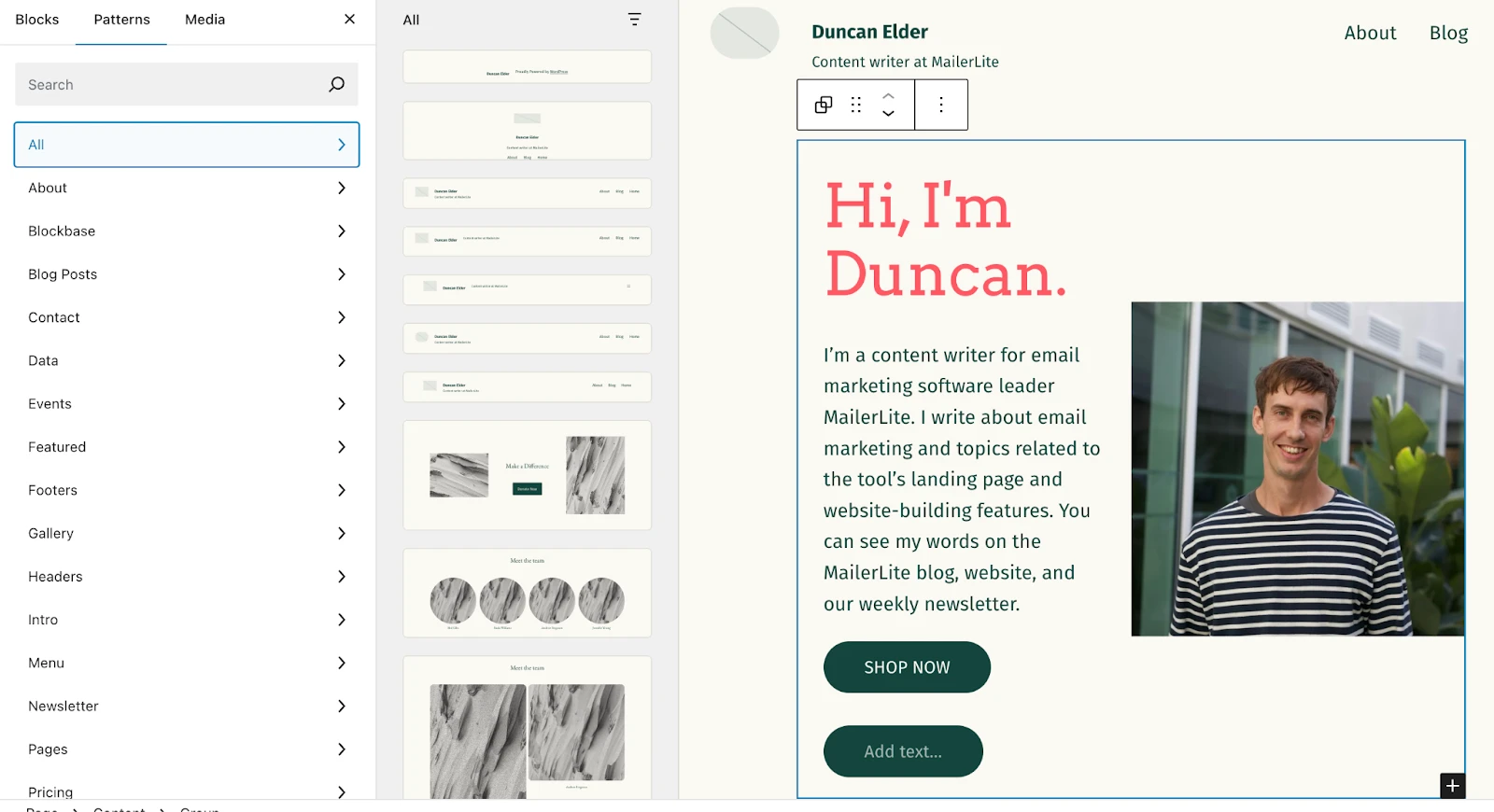
You can also create your own patterns by clicking on any block you’ve built and then hitting save. Reusing saved patterns is a big time saver, especially if you plan to use the same content on multiple pages.
Be aware when building your site that some site editor style options aren’t available on a free plan. If you add these, you’ll have to remove them before publishing. For example, we changed the background color, but weren’t able to publish the site until we switched back to the default.
We’ve built many WordPress websites, but still don’t find the tool particularly easy to use. The learning curve is steep and most people new to WordPress will have to spend at least a few days digging through the options and learning how the process works.
This kind of time is not a luxury many business owners have. Plus, even once you’ve discovered how the website builder works, your site won’t necessarily look as good or be as functional as sites built with the other, easier-to-use tools on this list.
Leading blog editor proven to help you create content that ranks on Google
A big reason to use WordPress.com is if you want to add a powerful blog to your website.
WordPress’s blog editor is one of the most feature-packed on the market. Blogs built with WordPress are effective at ranking on Google, which is a valuable way to drive traffic to your site.
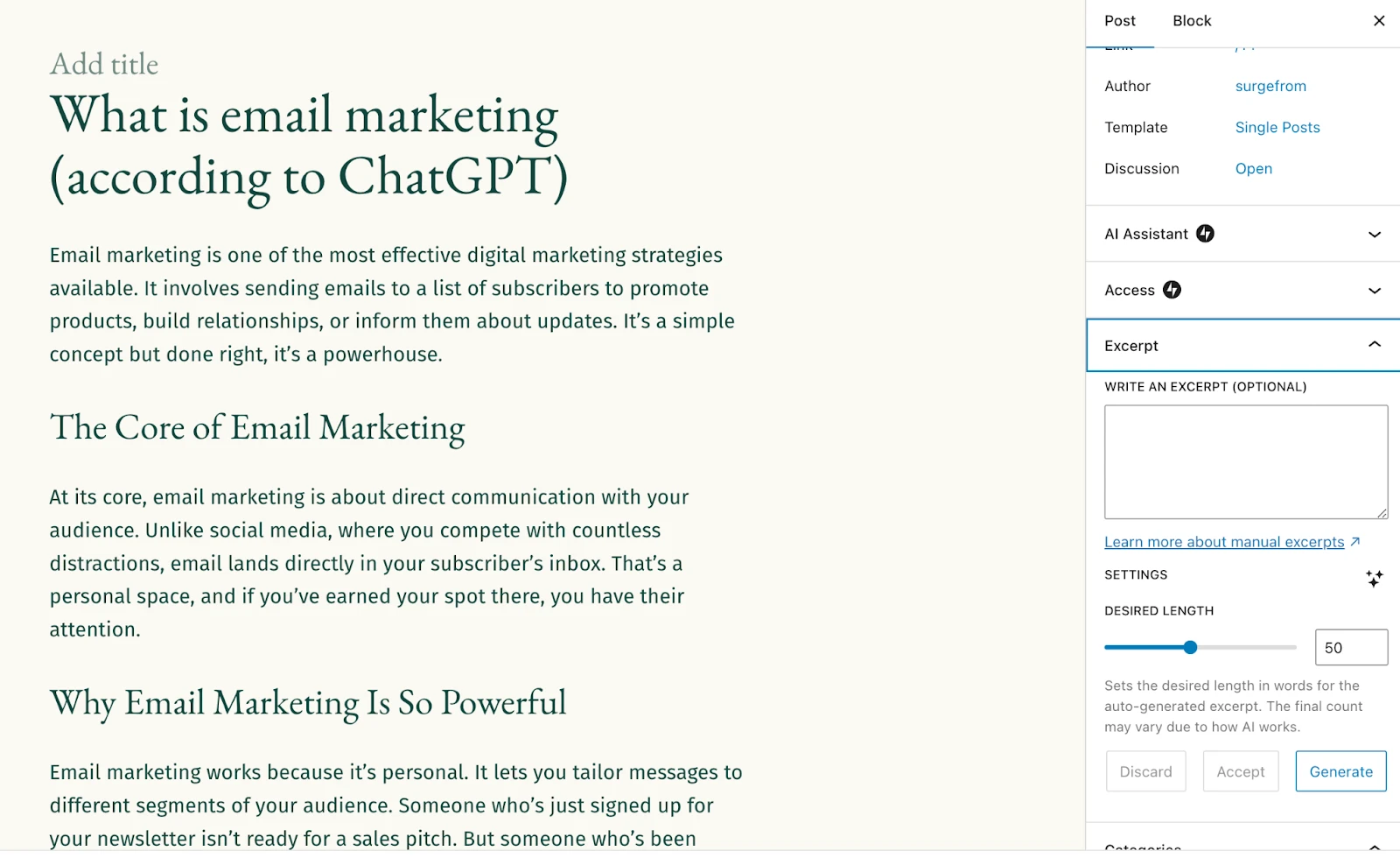
The blog editor gives you access to the same blocks as the page builder, so you have tons of options when it comes to creating beautiful articles.
You can also easily organize your posts by adding categories, tags, and creating custom URLs. All these options help both people and search engine crawlers navigate your site. You’ll boost the user experience and potentially get more search traffic.
However, as with the page editor, the blog post editor will take some time to get used to. If you just want to write and then hit publish, you might not be happy with the results.
Should you upgrade?
WordPress.com offers 4 plans ranging between $4 and $45 per month. To make the most of the tool, you’ll need the $25 per month Business plan or higher since this allows you to install plugins and themes.
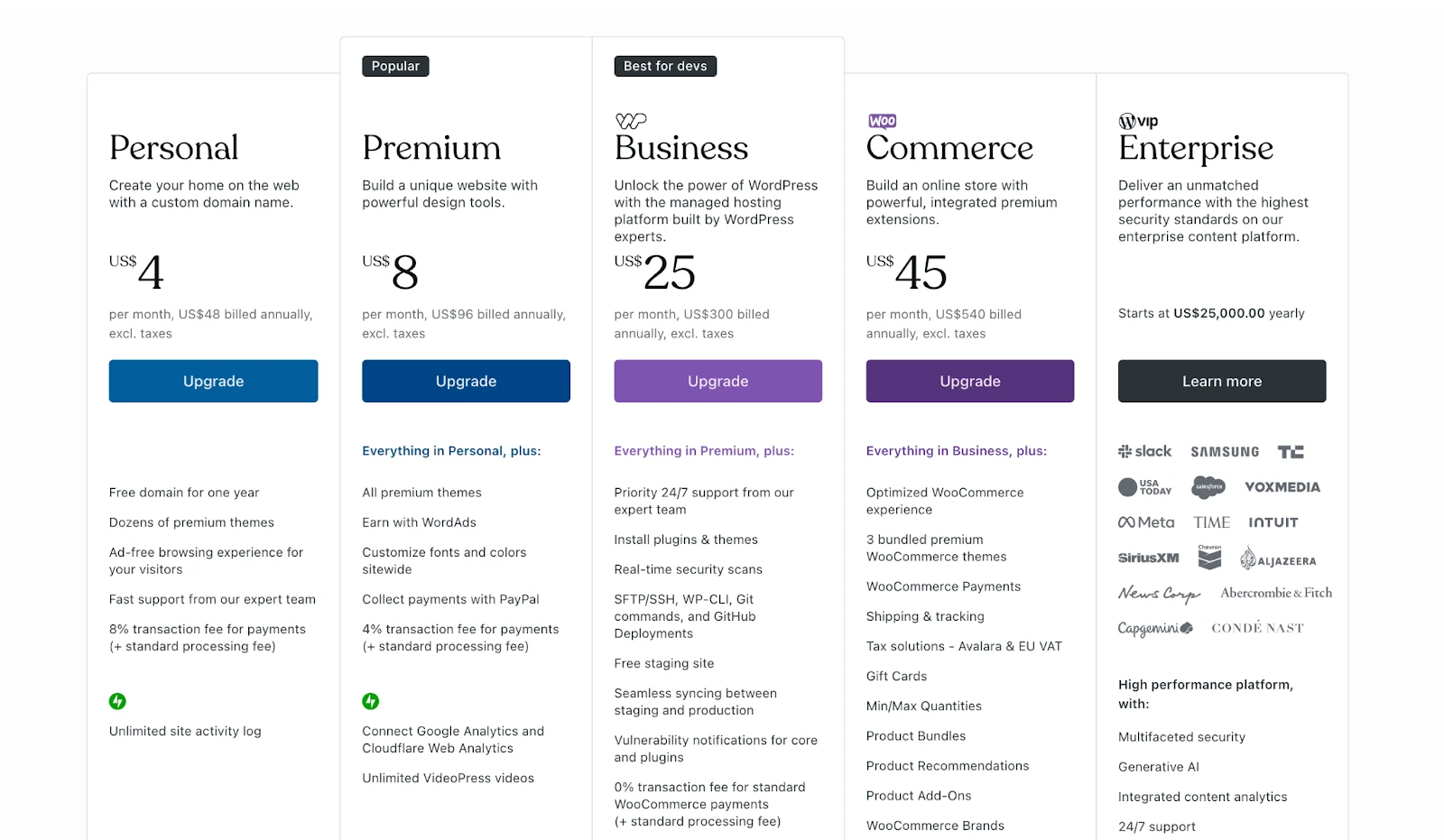
We think you should only use WordPress.com if you plan to upgrade. What WordPress lacks in user-friendliness it makes up for in customization and the ability to create powerful sites. But you only get these features with a paid plan.
Carrd: For one-page sites built in no time
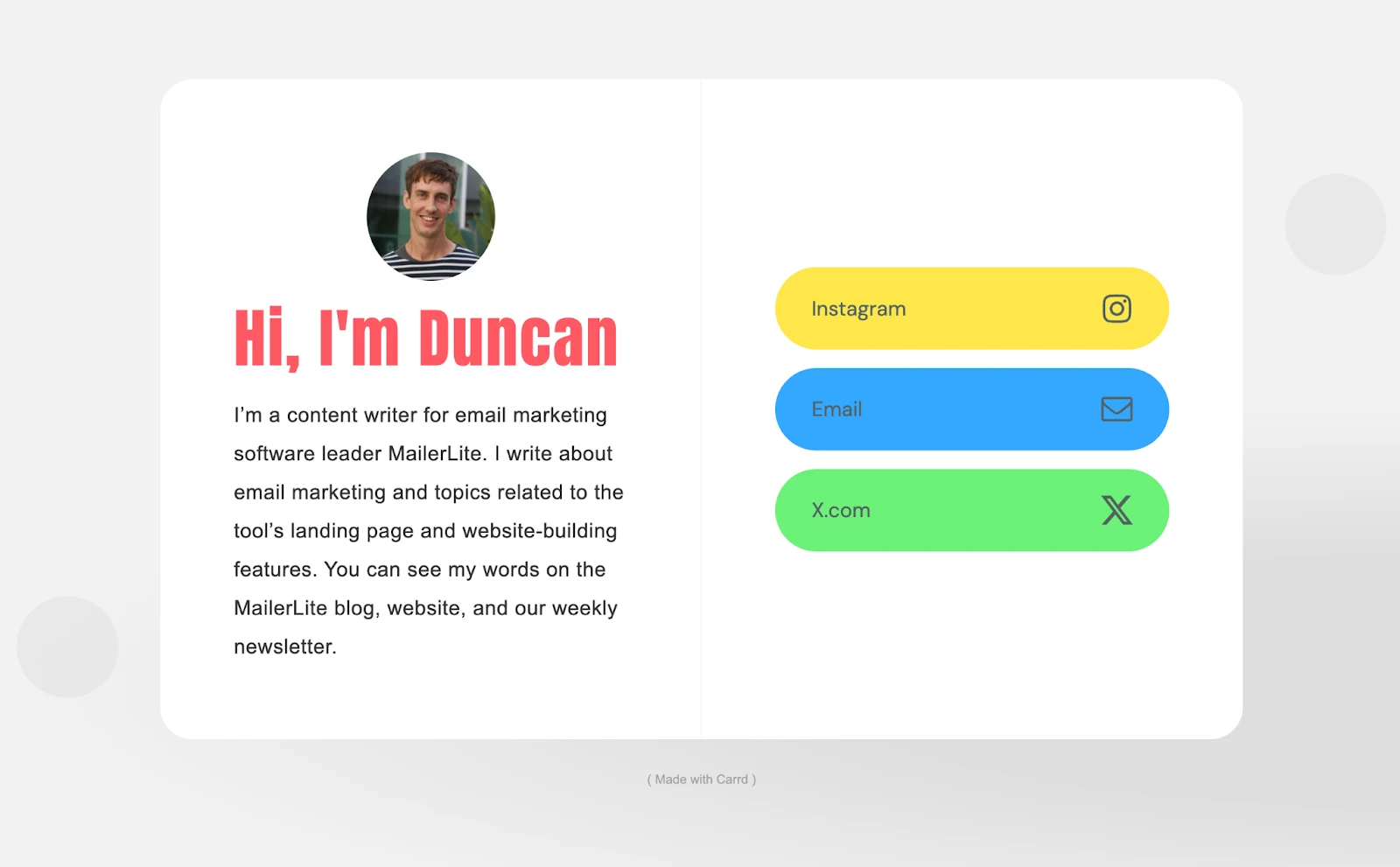
Carrd is a website builder for creating modern, single-page websites and landing pages. Creating beautiful designs is easy thanks to the user-friendly customization options: We’ve built plenty of free sites with the tool and are always happy with the results.
The biggest issue is that you can only create single-page sites. While this limitation can focus your mind and help you launch your site faster, it also means you can’t add blogs or pages for products, company info, or contact details.
Pros
Easy way to create beautiful one-page sites
Super quick setup
Modern website design
Tons of templates
Easy-to-use animation features
Paid plans are very cheap
Free templates available
Cons
One-page sites only
No pre-built layouts
Forms require a paid plan
The smoothest onboarding I’ve ever experienced
Carrd’s set-up flow is silky smooth. You can design your page without even signing up: Just choose a template and start editing!
Speaking of templates, there are plenty of options. They typically have very clean, modern designs. Some require a paid plan to access, though.
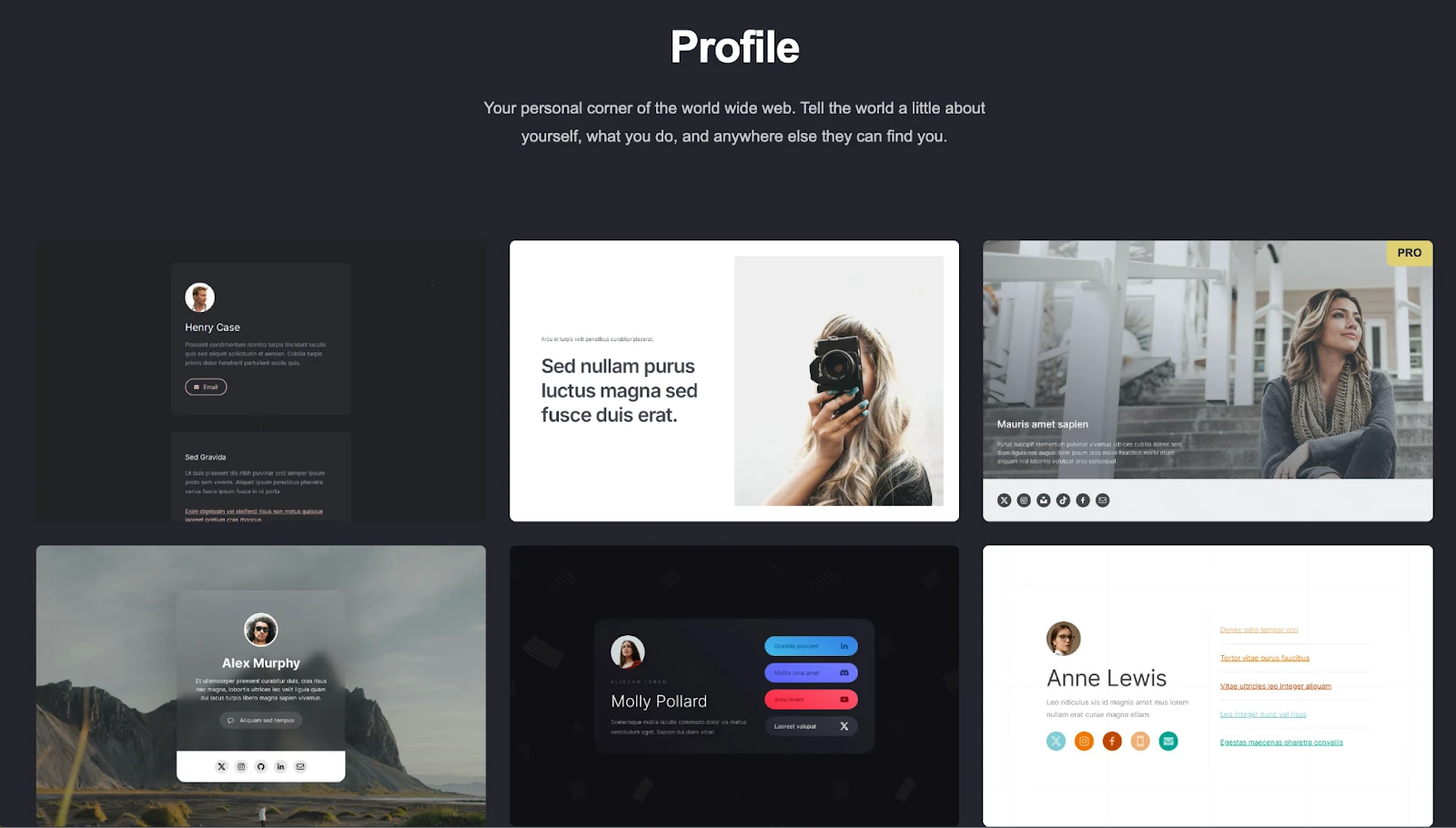
You can also start from scratch if you have a particular design in mind.
Simple editing
Editing any on-page element is easy. Just click on it and then choose from the options in the sidebar.
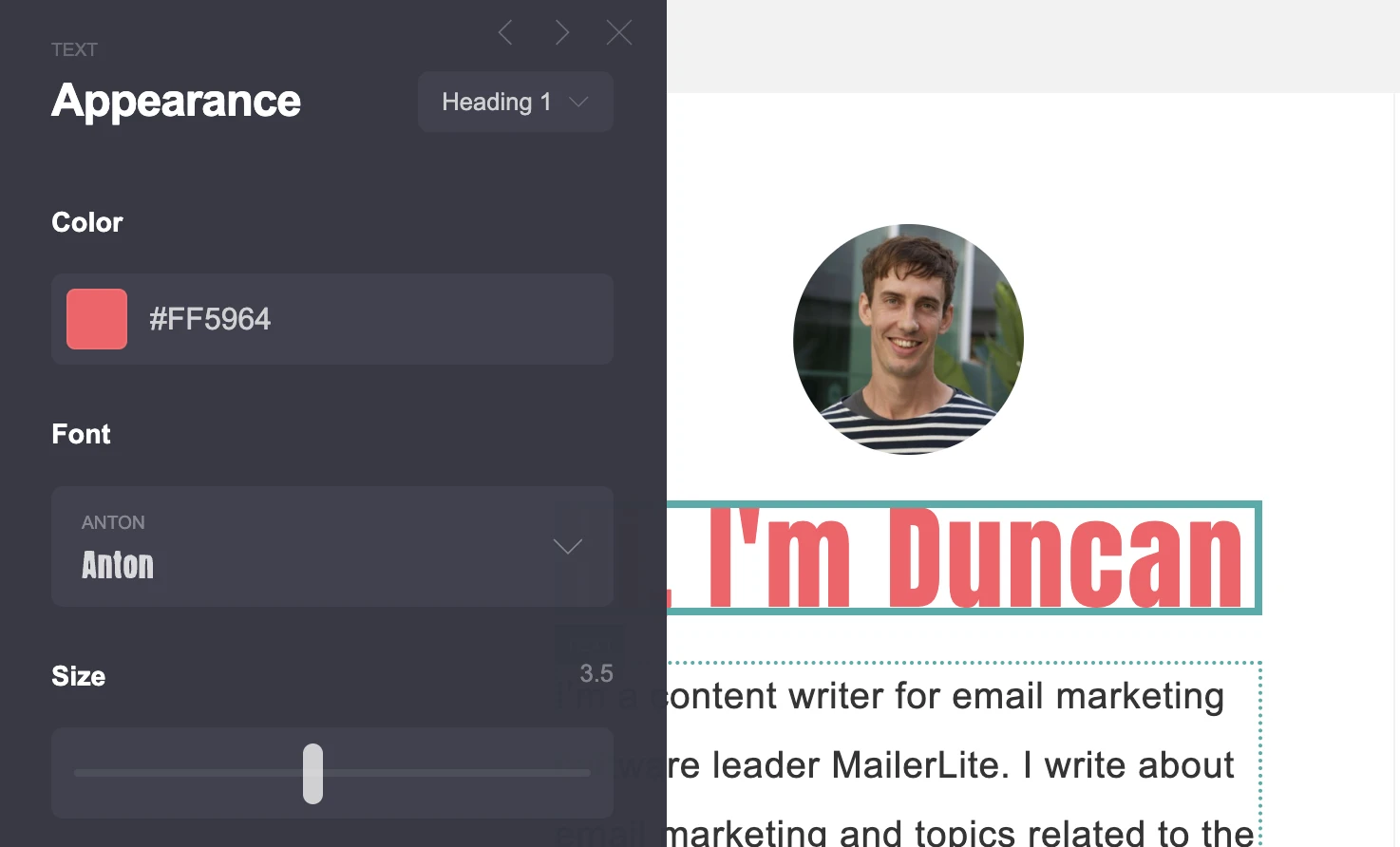
You get tons of flexibility and can change the color, spacing, height, fonts, margins, backgrounds, and more. The exact options depend on the block you’re using.
Use the container feature to design each section of your page. You can split this up into five columns to make more complex designs. Once you’ve created the section structure, drag the elements you need into the page.
This allows for a surprising amount of design flexibility, while still keeping all your pages organized.
I think it would be nice if the tool offered some pre-built layouts that you could simply drag into place. This would help business owners without much design knowledge get started faster.
One page limit, with a clever workaround
Since Carrd is a landing page builder, you’re limited to building single-page sites. This severely limits what a small business can do with their websites.
There’s no built-in way to add a blog or pages for contact details, about info, or products. This is essential content for many small business websites.
Carrd has a workaround that will work for some small businesses. The way it works is that you use anchors to link to specific sections on your website. This lets you create a menu or button that sends people to the relevant section.
Anchors are a relatively common feature. But Carrd goes further by letting you hide sections so they only show up when someone clicks to see them. The result feels similar to the experience you get on an app. It works pretty well!
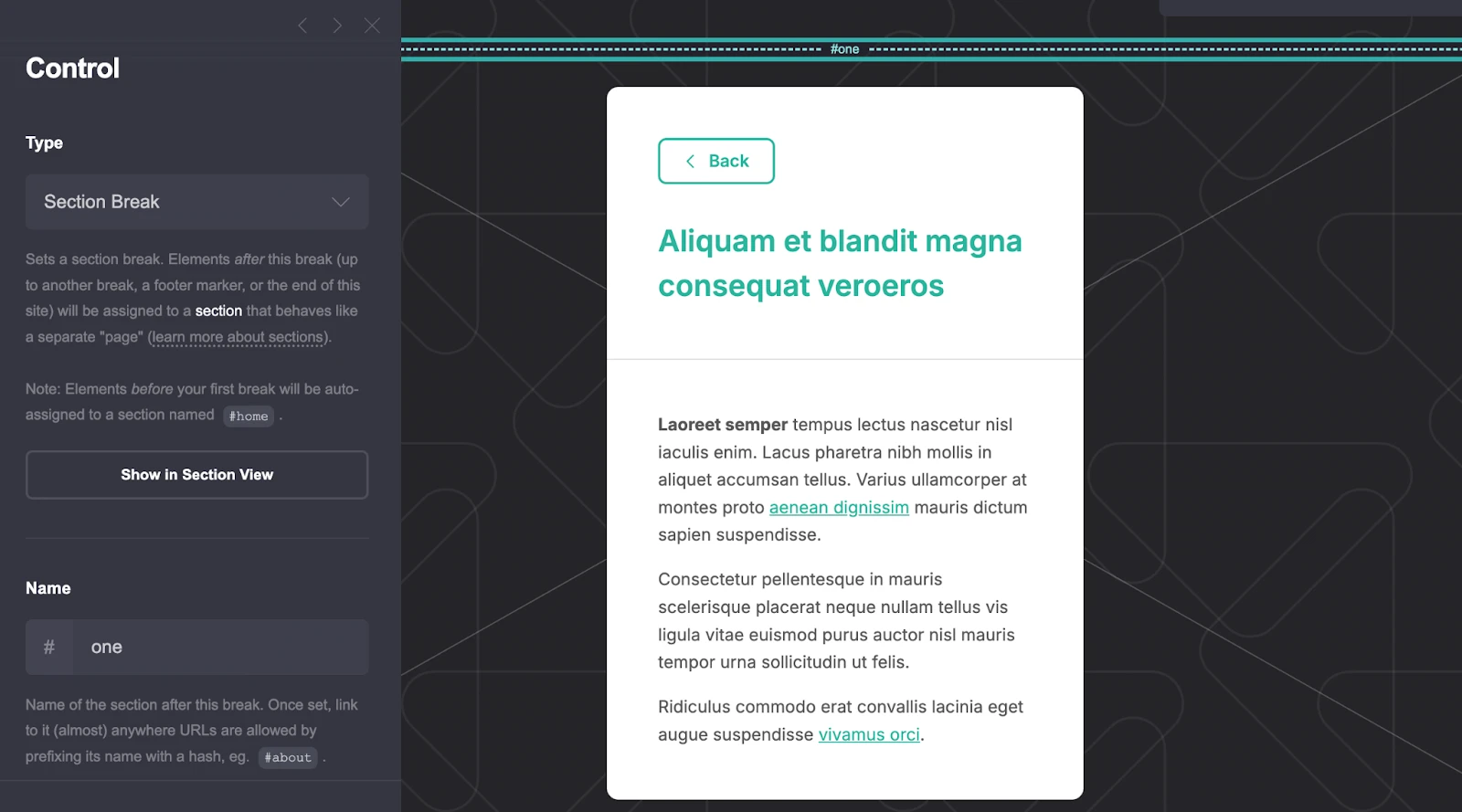
This workaround has limits though. For example, it will impact your ability to rank these pages on Google, since they’re not actually pages.
Cool and intuitive animation effects
Have you ever been on a website with animations that move as you scroll? Carrd lets you replicate this effect on your website with some simple settings.
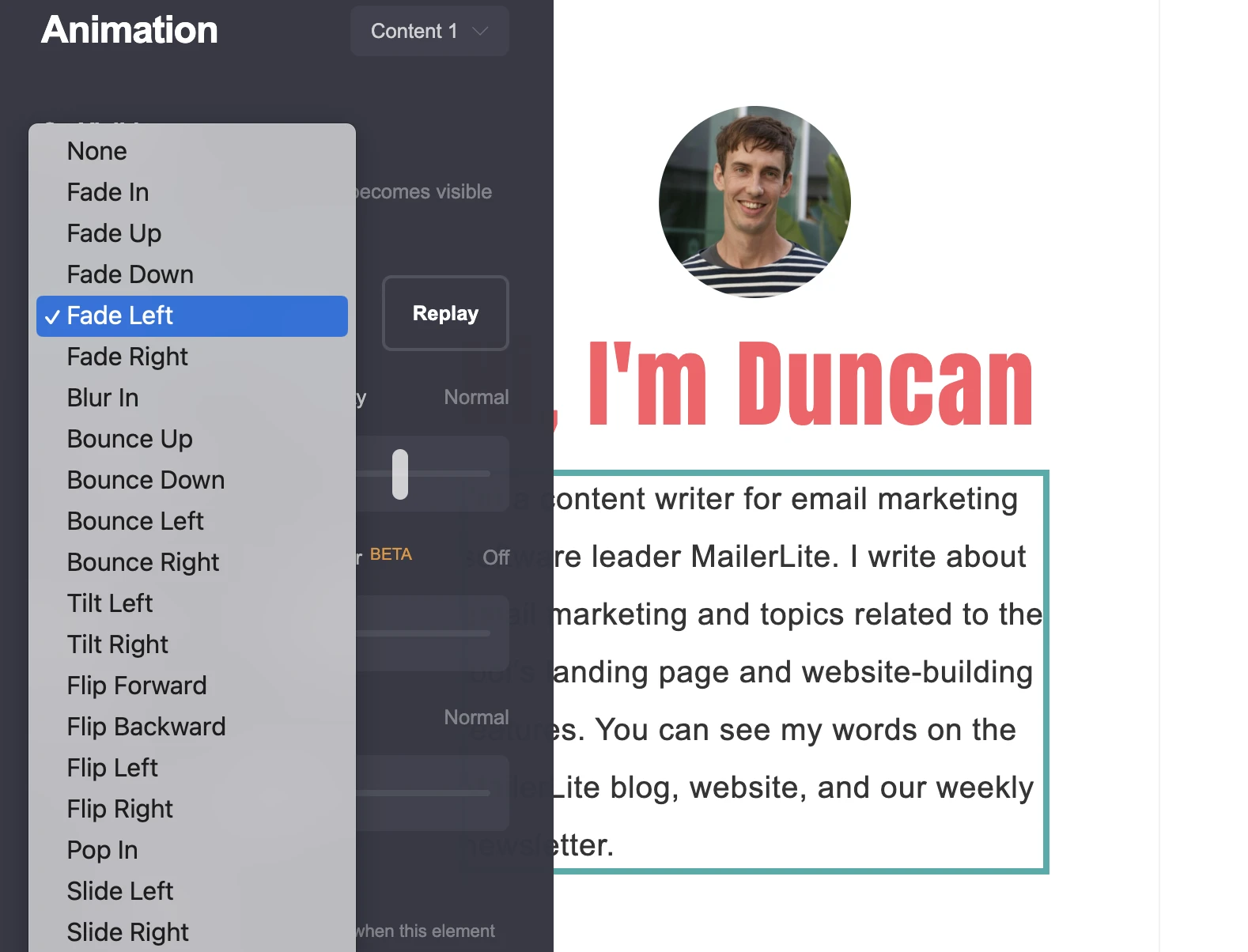
You can choose from many different types of animation and then adjust how long they last and whether to replay them on the second scroll.
It’s surprisingly easy to create professional animated effects that people will never guess came from a simple landing page builder.
Should you upgrade?
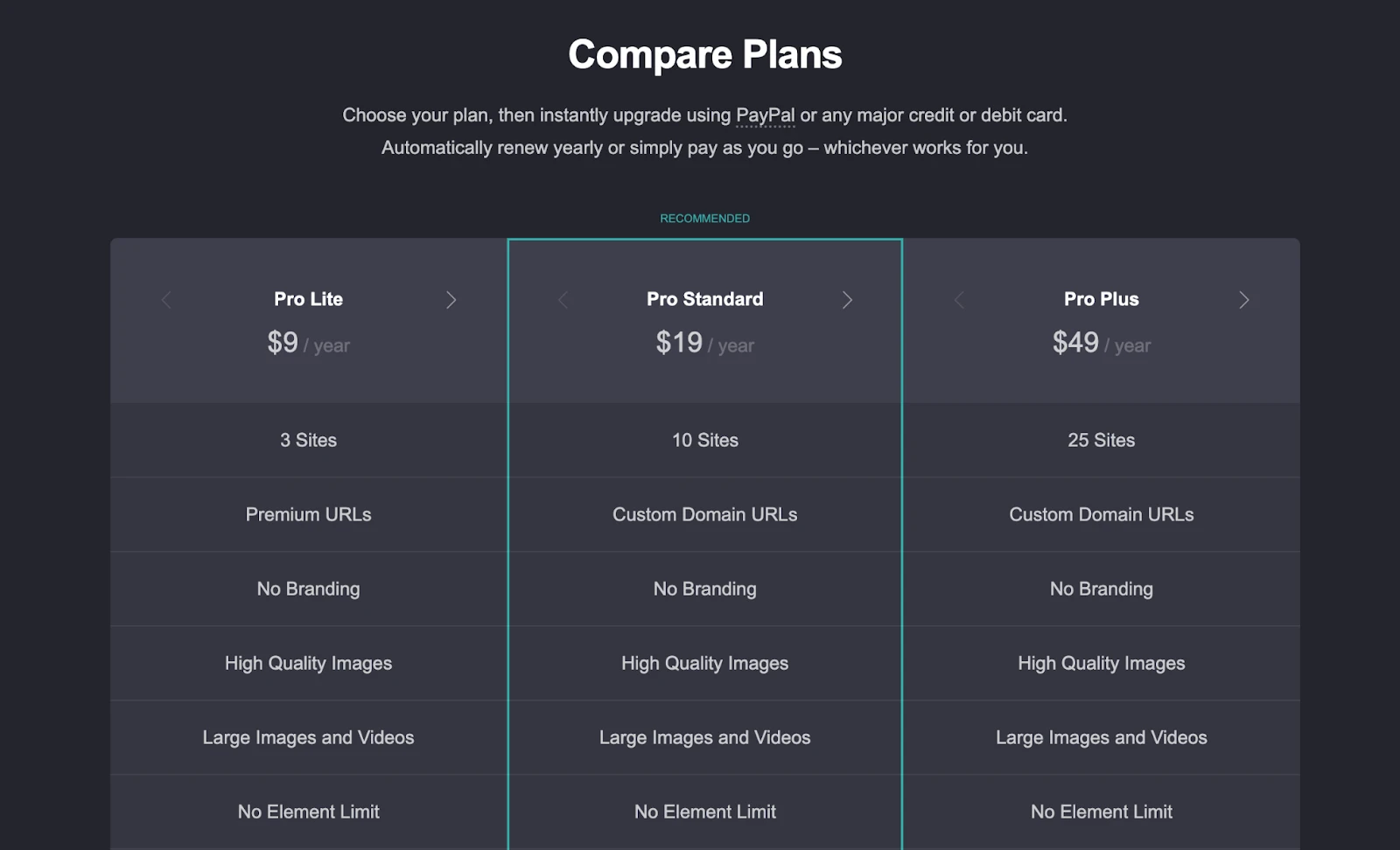
Carrd’s paid plans are super affordable. The three plans cost just $9, $19 or $49 per year. The latter two plans come with features like signup forms, custom code blocks, and the ability to add third-party e-commerce tools. We think these features will be useful for many businesses.
The biggest issue with upgrading is that you still don’t get the option to build a website with multiple pages or a blog. If this is something you think you’ll need at some point, you’ll end up having to pay for another tool on top of Carrd.
Mmm.page: For fun one-page sites with custom designs

Mmm.page is a super simple free website builder. Most of the tool’s features are available at no cost, you just need to pay if you want a custom domain or the ability to hide pages, add custom code, or handle more traffic.
The tool uses a Canva-like user interface that gives a ton of creative freedom. It’s a great tool for businesses that want a fun, simple page to introduce what they do, or a quick way to create a page while they build out a more feature-rich website.
While mmm.page’s simplicity helps you create pages quickly, it also means that it lacks many features you might expect from a website. For example, you can’t create multi-page websites, add forms, sell products, or collect email signups.
Missing these features is likely to be a dealbreaker for many small businesses. But if you don’t think you’ll need them and you’re happy with a single-page site, mmm.page is well worth a look.
Pros
True drag and drop editor
Publish page instantly
Create almost any design
Draw on your site
Make your page discoverable in the mmm.page feed
Cons
One-page sites only
No responsive design
No forms or e-commerce features
No templates
Set up was super simple
Getting started with mmm.page was insanely easy. After signup you choose a username and, tada!, your new business website is live. We’ve never had a page up quite so quickly.
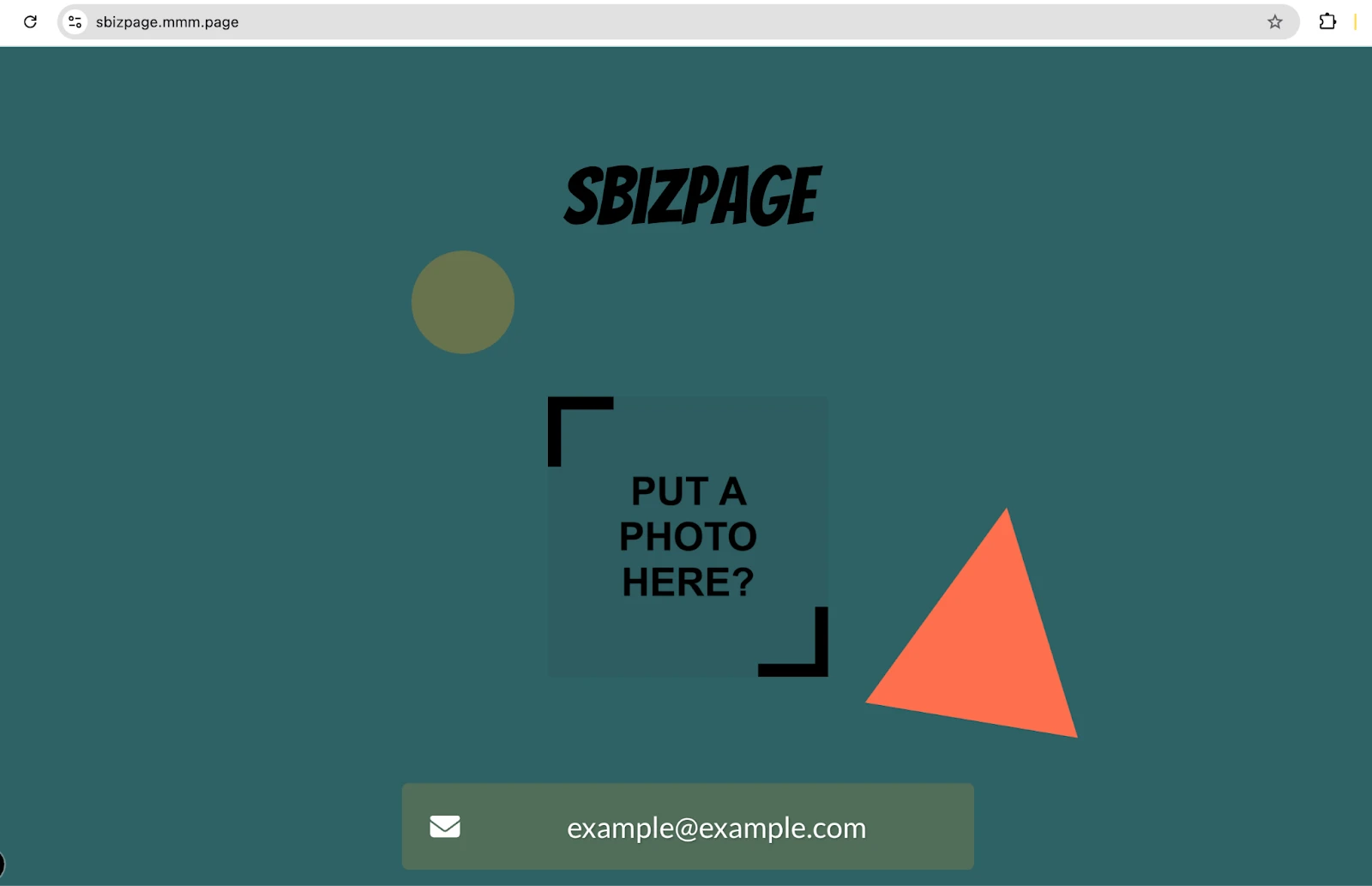
Of course, it’s just a default design. But, having the page live feels like a big step crossed off your list. Now it’s just a case of making the page your own.
Editing the existing elements was a breeze. It’s a true drag-and-drop builder, so you can literally take an item and put it wherever you want on the page.
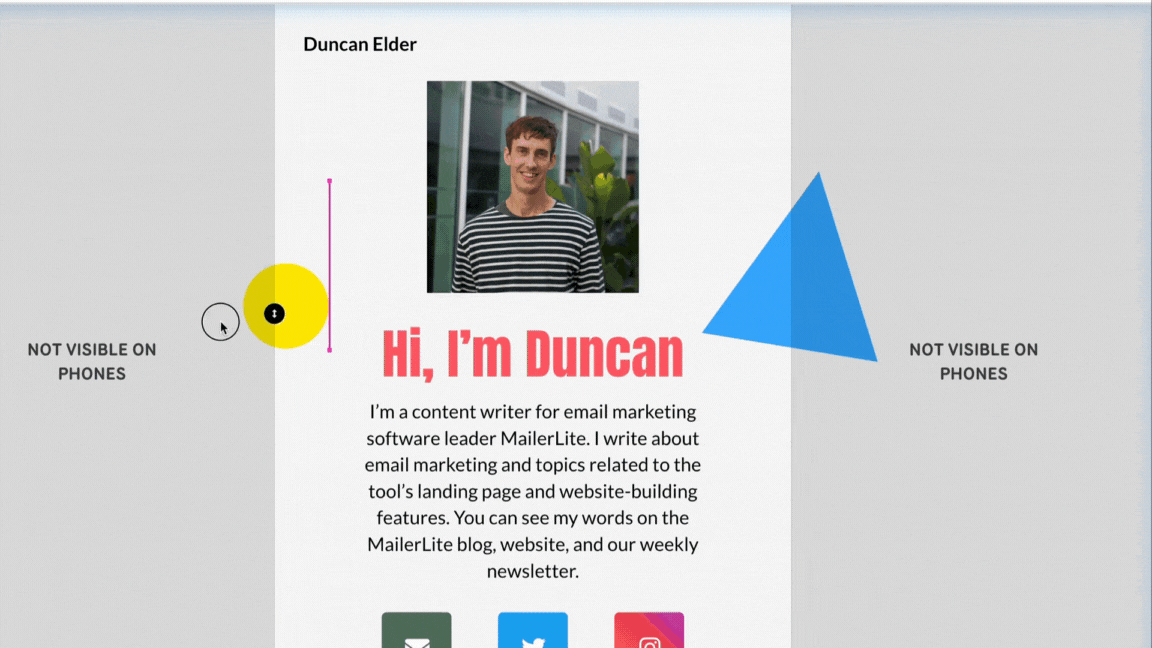
Plus, when you click on an item you’ll get options such as adding links, changing colors, editing text, or changing the layer priority. It’s all super seamless and is really quick to work.
Adding new elements to your page is easy too. Select elements like shapes, stickers, text, and buttons from the sidebar and drag them onto your page. You can add images by dragging them in from your computer’s file manager and dropping them directly onto the page.
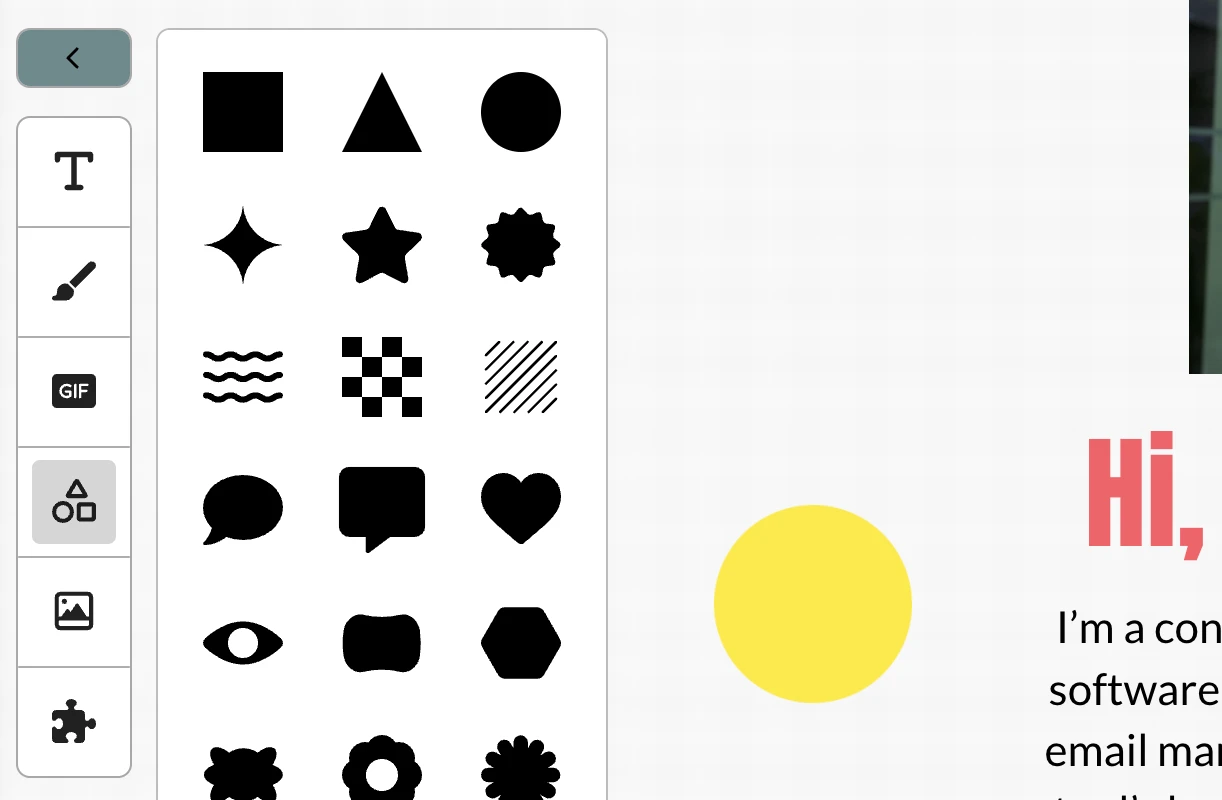
You can even use the Draw option to draw on your webpage with your mouse. Just choose the color and brush thickness and start drawing. It’s like Microsoft Paint for websites.
This freedom opens up a ton of design flexibility. But one downside is that it can be harder to get spacing right than in tools that use premade blocks. Especially if you’re not a designer (as we’re not).
mmm.card’s solution is the helpful spacing lines that appear when you’re dragging elements around.
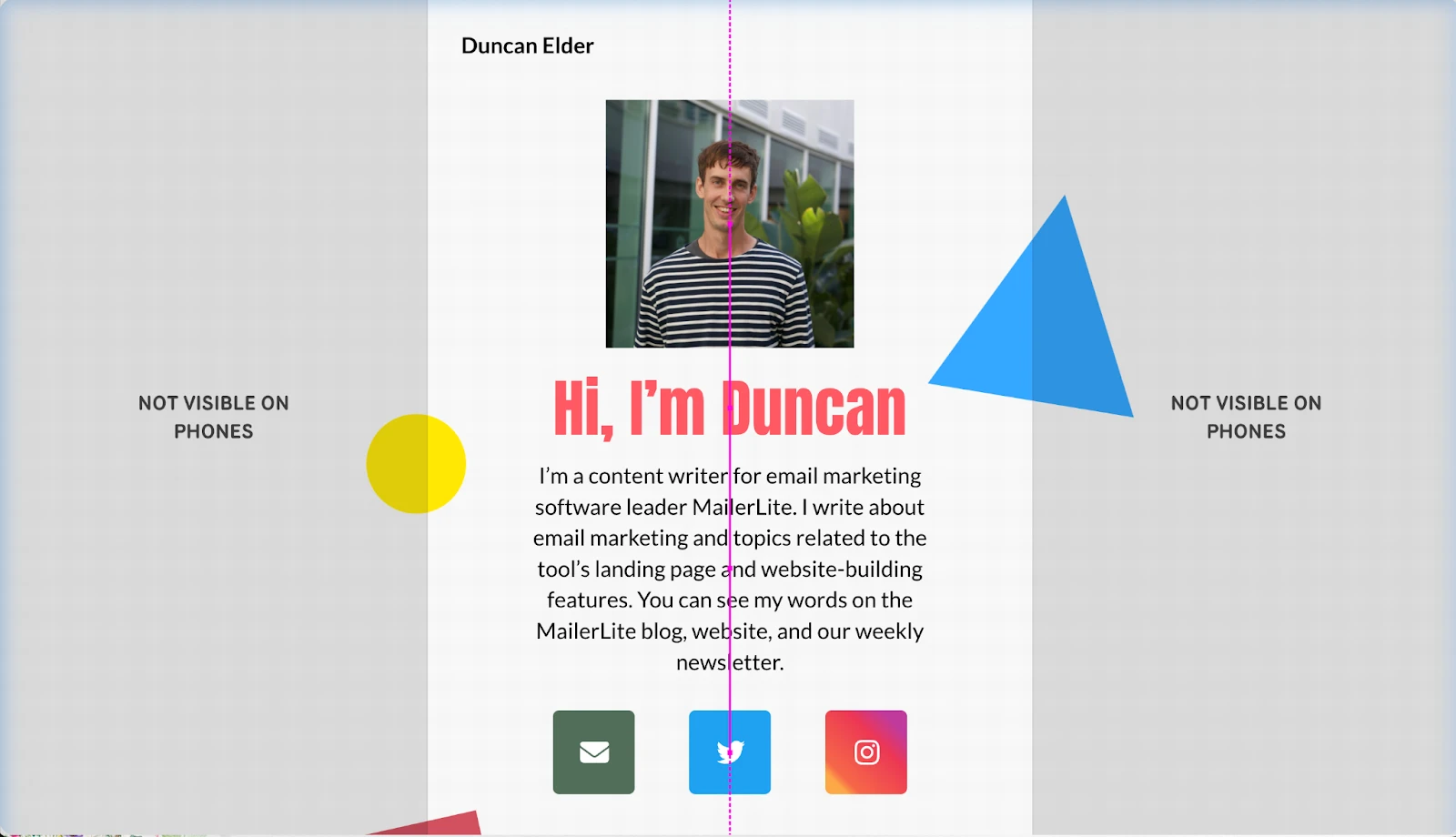
These lines show you spacing hints such as where the center of the page is and the spacing between two elements. Canva has a very similar feature, so if you’ve ever used that design tool you’ll know exactly how useful these guidelines are.
These features helped us create a simple design with spacing that looks pretty good. But it would be harder if we had to make a more complex design.
Pages aren’t responsive, but there is a workaround
Websites built with mmm.page are not responsive, which means the design won’t change when viewed on different screen sizes.
But, the site builder has a simple workaround: When you’re dragging elements, the builder shows which parts of the page won’t be visible on phones.
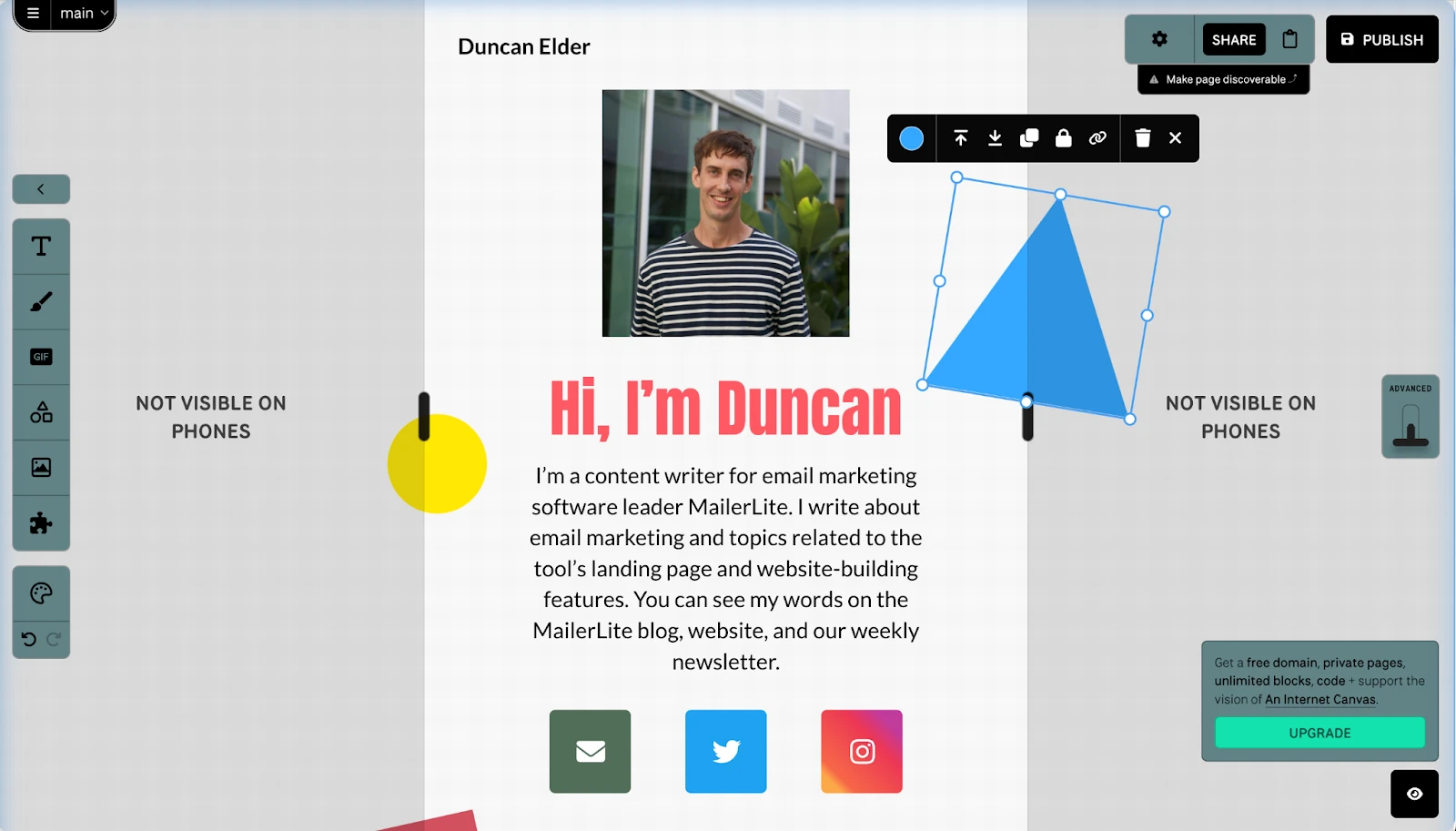
This lets you put your most important content in the center of the page where it is sure to be visible on all devices.
Should you upgrade?
Mmm.page’s free plan is enough to create pages, publish them on a custom domain, and get up to 1,000 monthly visitors.
If you want more, the tool has three upgrade options priced at $6, $12 and $30 per month.
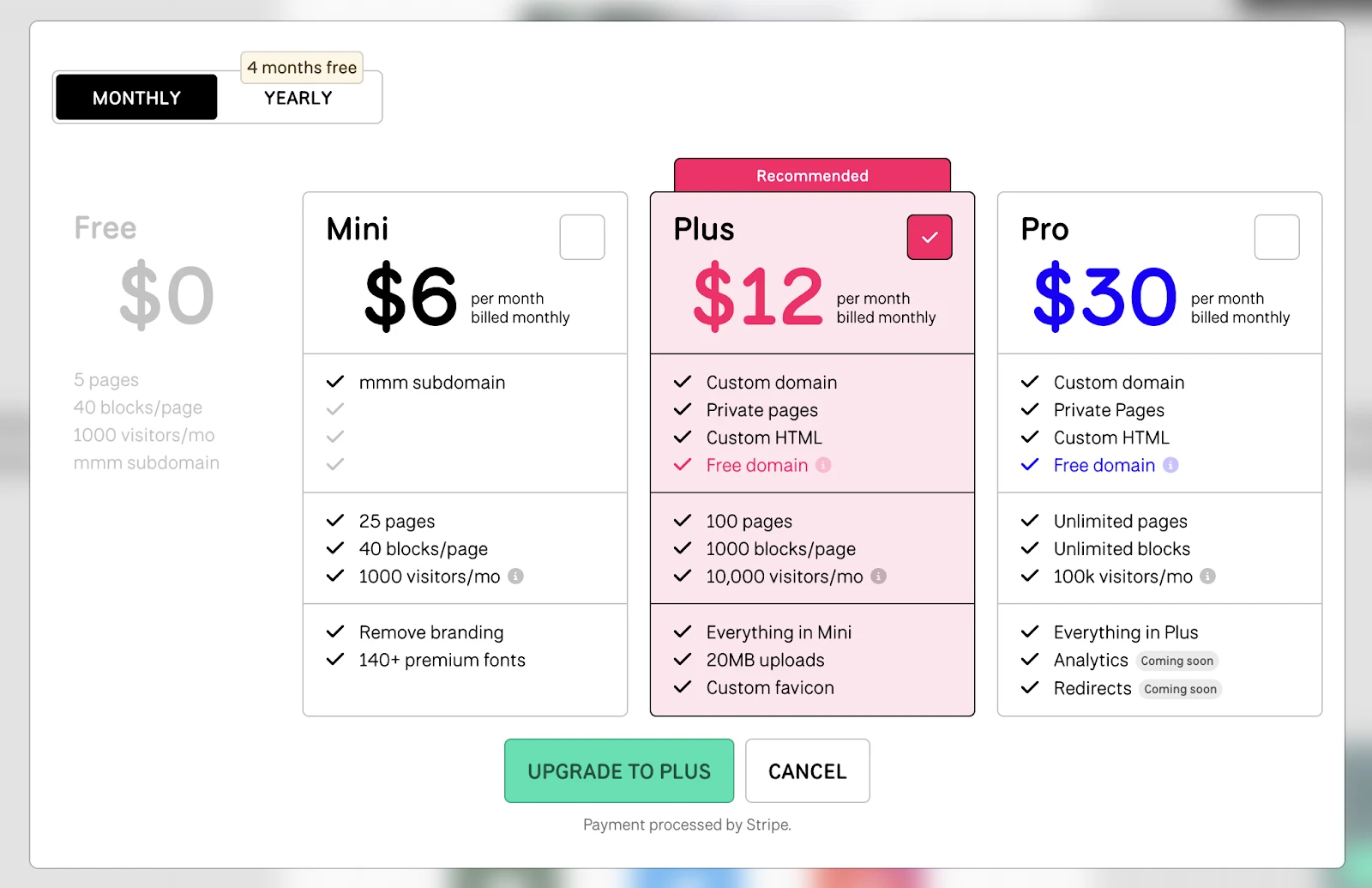
The latter 2 options are most appealing since they come with a free custom domain and the ability to add HTML to your pages.
The HTML feature would open up a ton of options through the ability to add either your own code or code provided by other platforms. This would let you, for example, add email signup forms to your page.
Ycode: For design freedom and complex apps
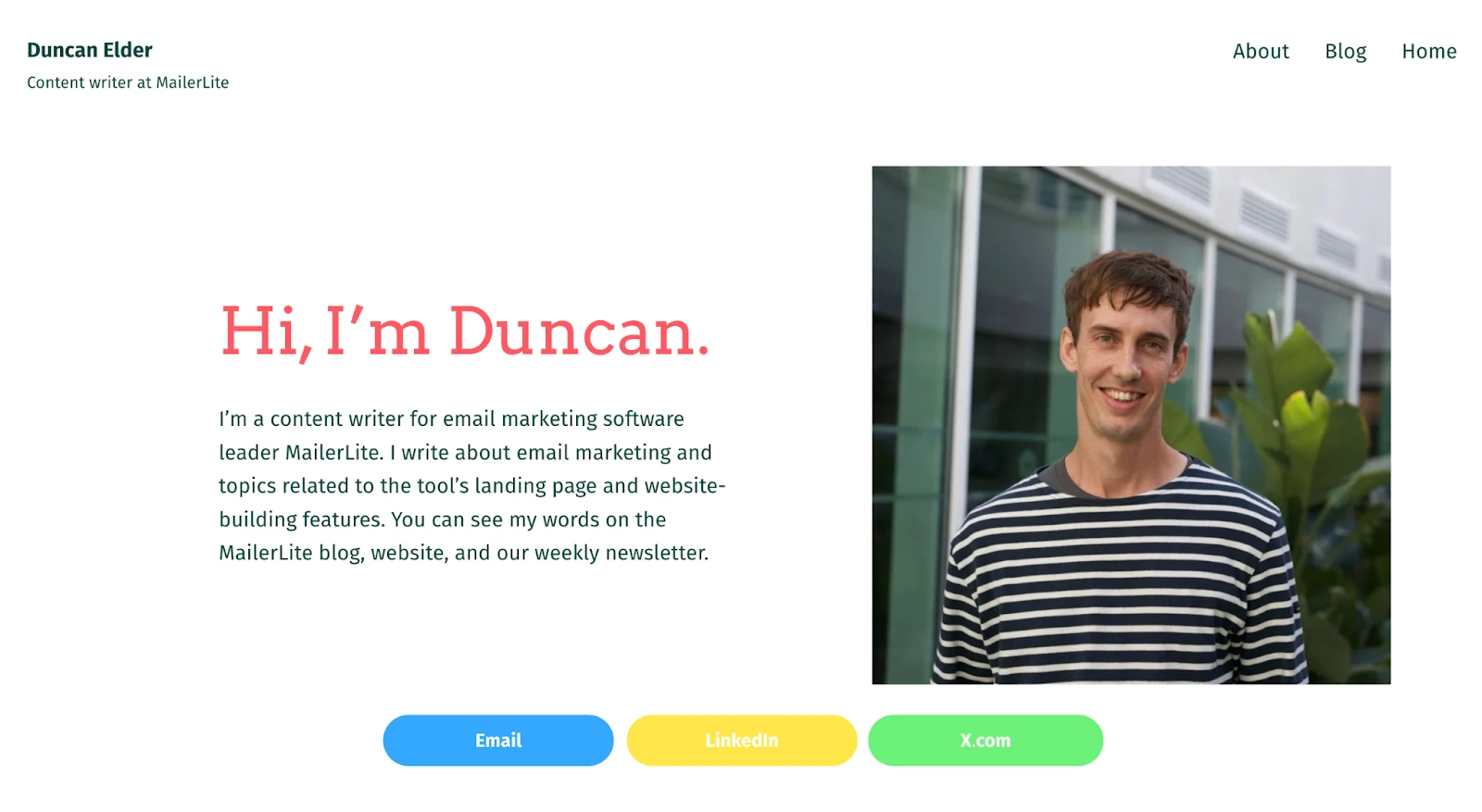
Ycode is a website builder with tools that let you build professional websites with advanced features. You get full design customization, can add filterable and searchable content tables, and can set up automated workflows based on user interaction.
The tool has a solid free plan for websites with up to three pages that get under 1,000 monthly visitors. This will be enough for many small business websites. Plus, if you can stick to the premade templates and layouts, the free website builder is an intuitive way to build a custom website.
The tool goes beyond with plenty of advanced features and customization options that designers and experienced website builders will love. But getting to grips with these tools could be a more time-consuming process if you aren’t familiar with website builders.
Pros
Good selection of business templates
Premade layouts are easy to use
Tons of design options
Form builder in free plan
Advanced features like filterable lists, conditional visibility, and workflows
Good pricing if you choose to upgrade
Cons
Advanced features are hard to use
Design customization can be overwhelming for beginners
Starting with a modern template
Getting started is easy. Once you’re signed up, choose one of the templates or start from scratch.
The templates are all modern designs that work well for small businesses. There’s everything from one-page, link-in-bio-type designs to complex multi-page websites.
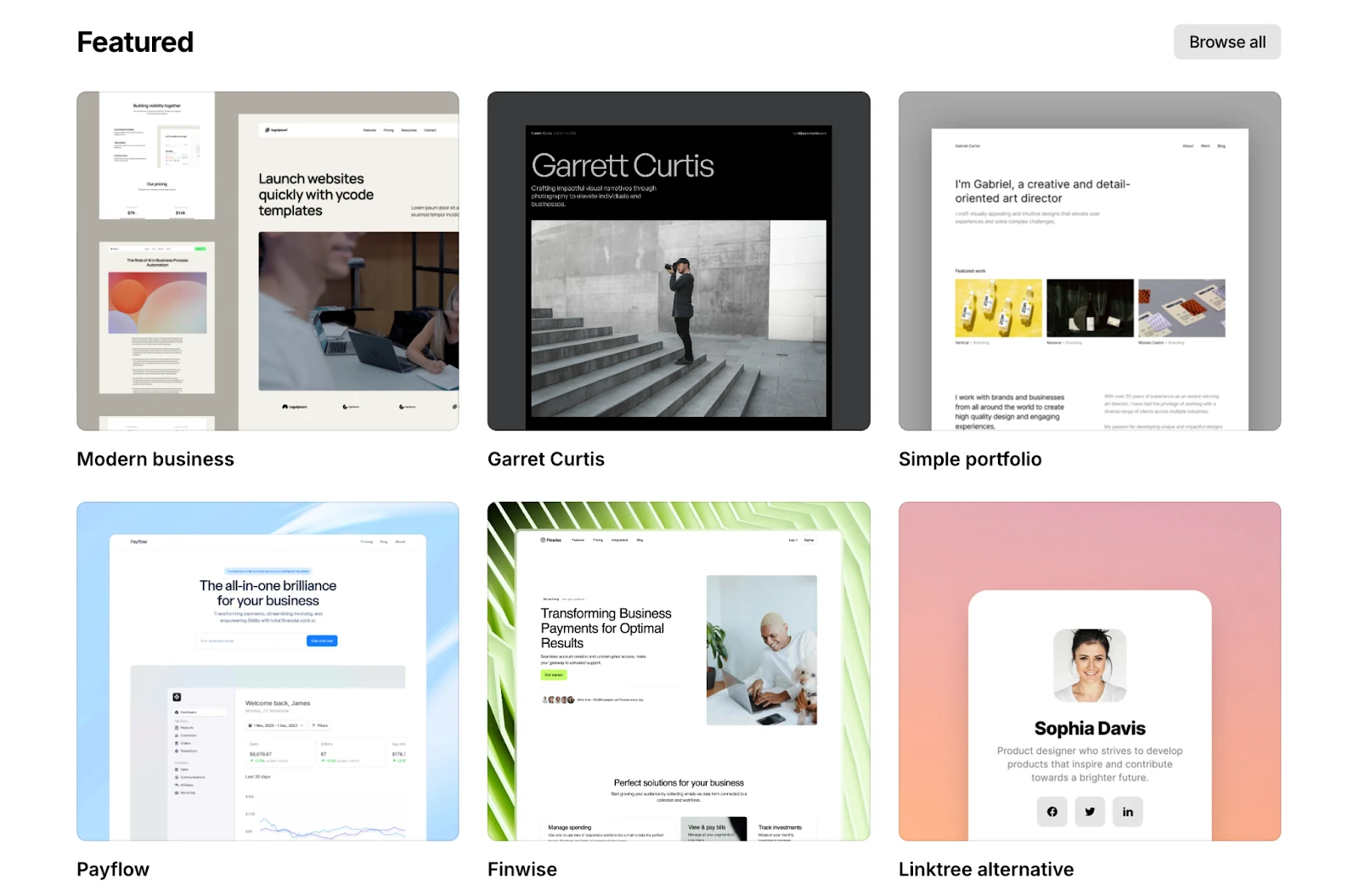
I think most brands will be able to find a template that works for them, which will make the web design process much simpler.
Design is a breeze with premade layouts
Editing content with the template you choose is easy. Click on the content you want to change and edit it directly. Or, get further options in the right sidebar.
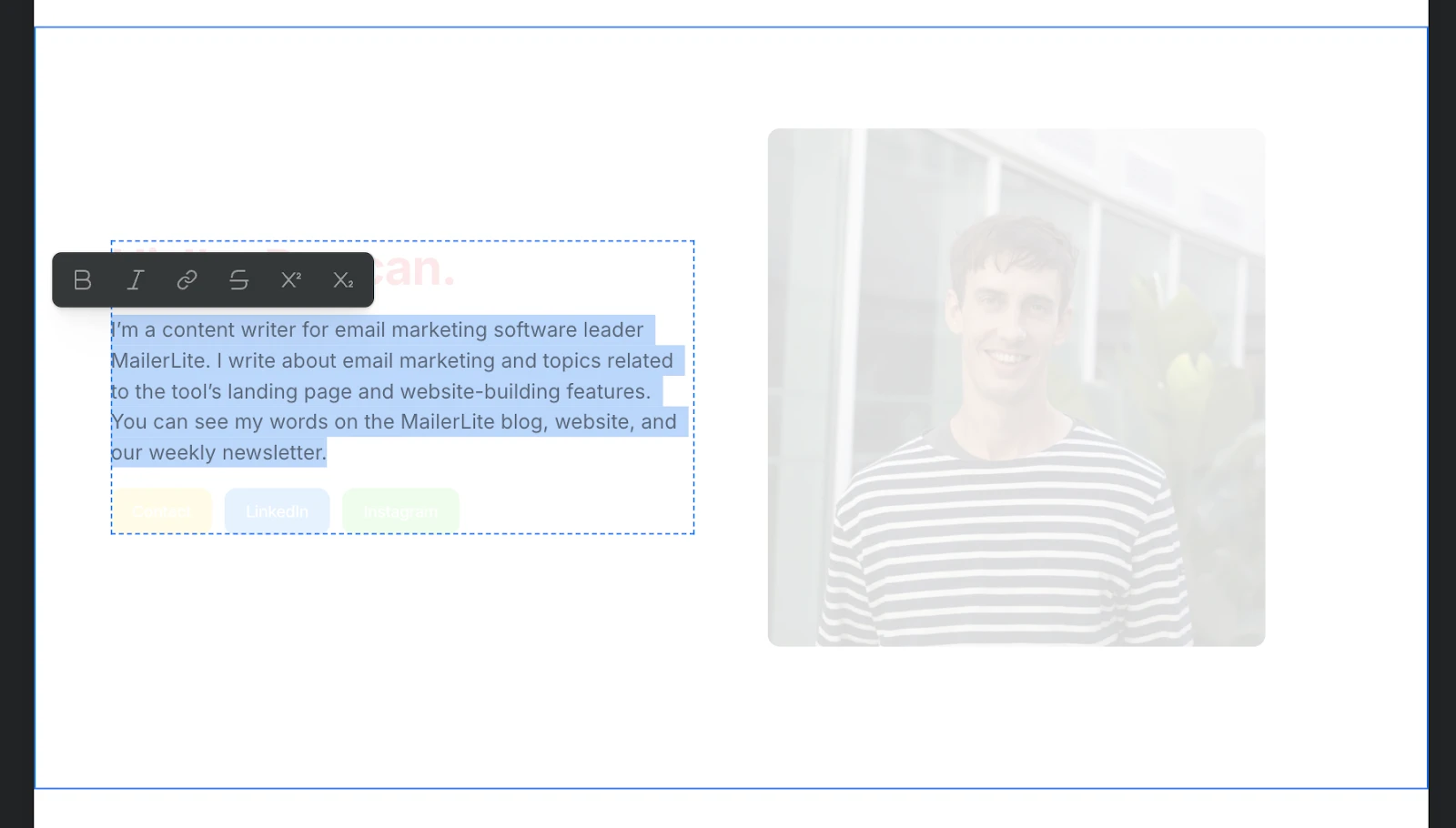
Adding new content via the pre-built layouts is also really easy. Choose from the 24+ options and simply drag your chosen layout into your site and adjust the content. You’ll find the most common website layouts in this section.
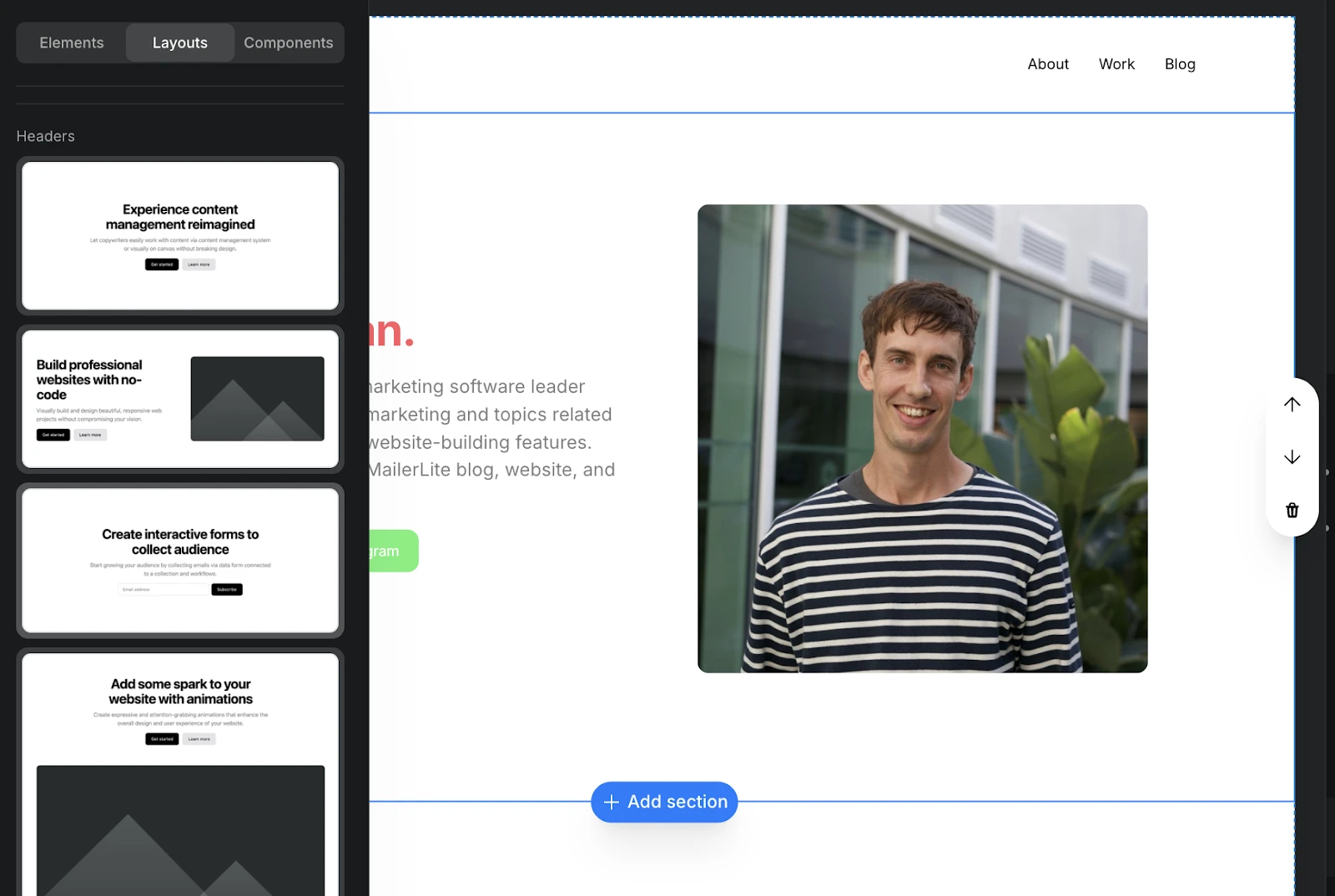
If you ever want to save a layout of your own, you can easily do so and reuse it across your website by creating a component.
Most people will be able to create a decent website with these options.
Go deeper with advanced design options
Ycode is really a design platform, so if you have design skills or want to go deeper, you’ll have plenty to experiment with.
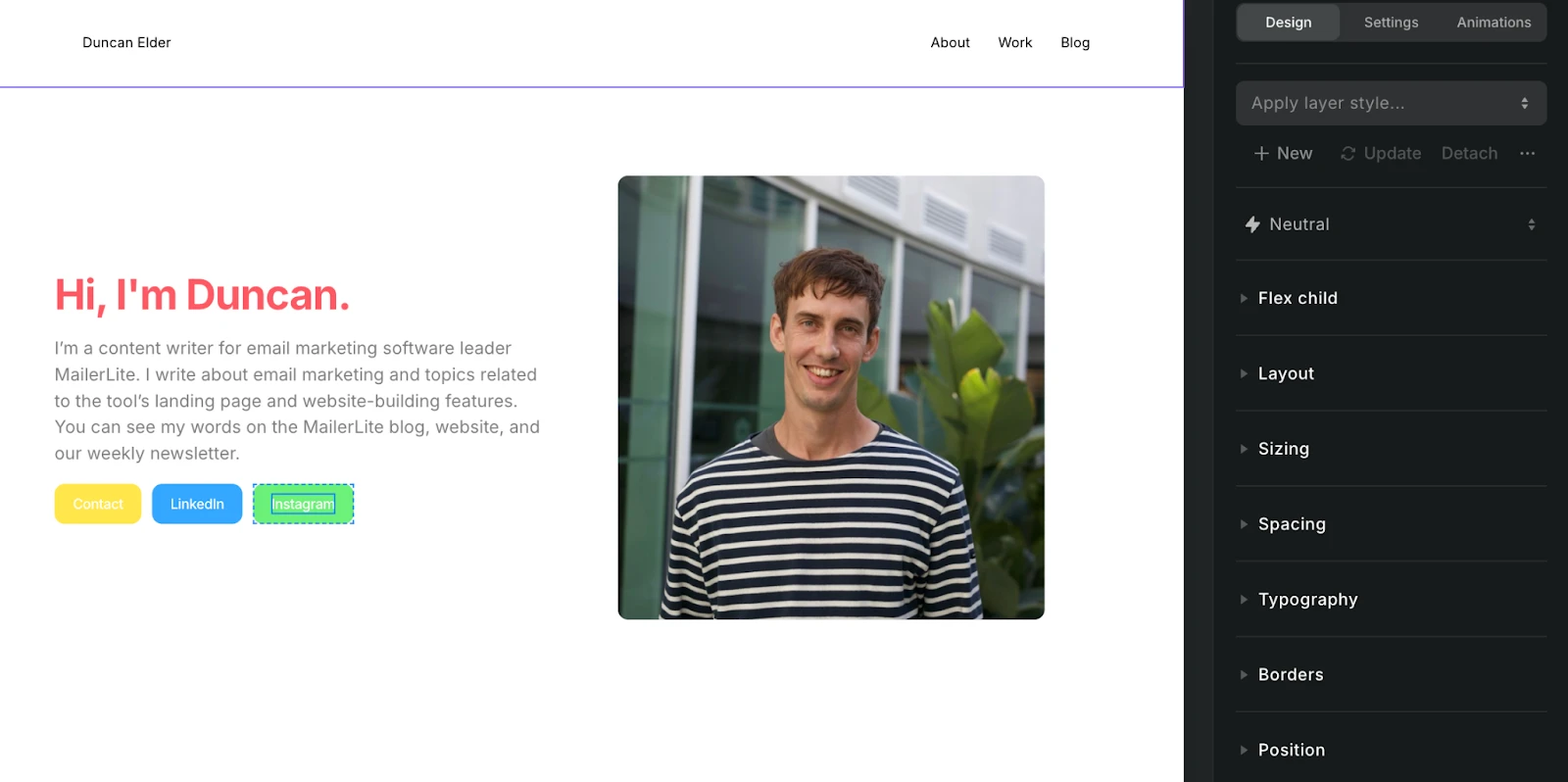
Get granular with spacing, colors, typography, animations, effects, and more. Or use conditional visibility to hide elements in certain situations. You can also create filterable lists based on content in your CMS database.
Plus you can create and reuse styles across multiple components to keep your design consistent.
The issue is that beginners who want to create their own website will struggle to use these features. It’s easy to get lost due to the vast number of customization options.
That’s not a criticism of the tool, as it’s designed to be a platform used by pro designers. But it’s something to think about if you want an easy way to create a simple site.
Should you upgrade?
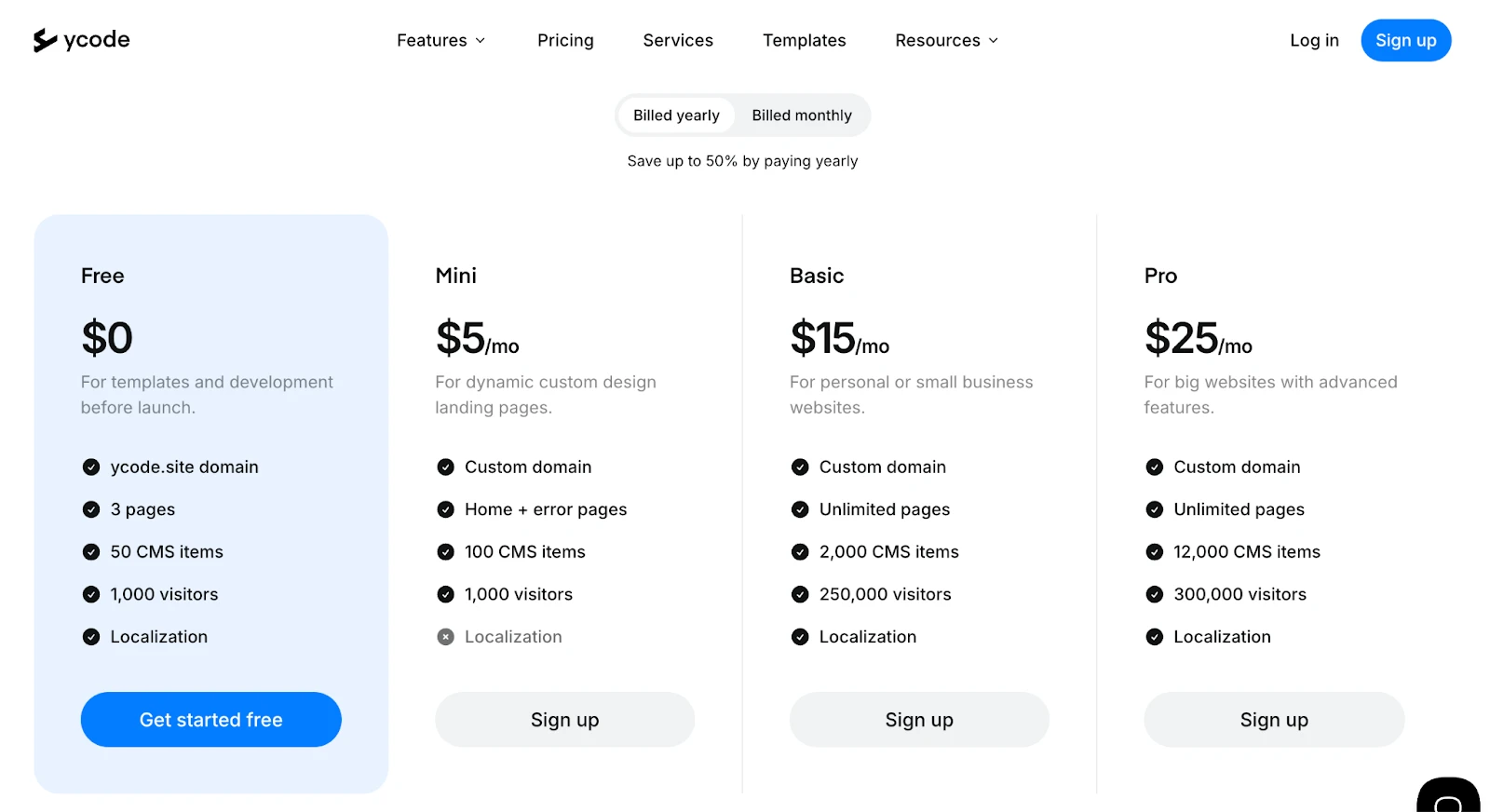
Ycode offers 3 great value, paid plans starting at just $5 per month. The free plan is pretty generous and contains all the features you’re likely to need for small websites.
Consider upgrading if you want to use a custom domain with your business or add custom code. The $5 per month mini plan is one of the most affordable options for a website builder with this many tools, and it gives access to all features other than localization.
If you want to go deeper, the more expensive plans are also great value considering the monthly visitors and database items available.
How to choose the best free website tool for your needs 🤔
Most free website builders offer similar functionality, but they aren’t all exactly the same. Here are 8 questions worth considering to ensure you choose a tool that works for your business.
Does it have the right blend of usability vs. customization?
Some of the tools on our list, like MailerLite and mmm.page are super easy to use, while others, like Ycode and WordPress, have more features and customization options.
The right blend of ease of use and customization for you will depend on what you want from your website, your web design skills, and the time you can put into building your site.
Read this article to learn more about how to build a website.
How much bandwidth (traffic) can the site handle?
Many website builders limit the bandwidth free users can access, meaning sites can only handle a limited number of visitors each month. Think about how many visitors you expect your site to get and ensure the free plan can handle this.
Can you add forms to the site?
Forms are an essential feature for almost all business websites as they enable visitors to contact you, join your email list, and convert into prospects.
Without forms, using your website to generate customers will be much harder. Unfortunately, many free plans limit your ability to add forms, so choose wisely! MailerLite, Wix and Ycode all let you add forms to free sites.
Are there limits to what you can build?
Many free website builders restrict the storage, pages or content blocks you can add to the website. This can be a problem if you want to make a large site.
Does the free plan include advanced blocks?
All the tools on our list have similar base features and design options. Some also have extras that help you create more advanced websites, such as quizzes, surveys, animations, and more.
Are there any extras that make the tool a good fit?
Many of the platforms on our list have extras that can’t be compared to other tools. For example, MailerLite provides advanced email marketing features, Ycode has filterable lists, and mmm.page lets you take your mouse and draw on the website canvas.
What features do paid plans offer (and are they affordable)?
Many businesses start with a free website and then switch to a paid one as they become more established. If you think you’ll need to upgrade at some point, look at the pricing and features available on paid plans to ensure the tool will grow with you.
Website builder FAQs
Still unsure about whether to use a free tool to build your business’s website? Here are the answers to some common website-building questions.
Is it really possible to build a website for free?
All the tools on our list let you build a website for free, but you have to make some compromises if you don’t want to pay.
The biggest compromise is that you can’t publish the website to your own URL because it always costs money to buy a domain name. Instead, you’ll publish the website to a free domain provided by the tool you choose.
Even if you register a custom domain, which typically costs from $10 per year, most free site builders require you to upgrade to a paid plan to connect it.
Other compromises will depend on the tool you choose. They typically include some of the following:
The number of pages you can add to your website
The number of visits your website can handle in a month
Access to advanced features like e-commerce, forms, or blogs
The requirement to show the website-building platform’s branding on your website
A limited number of user seats
With this in mind, the key to choosing a free website builder is to identify which compromises you are willing to accept and then choose a tool that meets these criteria.
How much does it cost to build a website for a small business?
Paid plans start at just a few dollars per month, although these plans will typically still be limited. For a serious website, look to spend $10 or more per month plus between $10 and $60 annually to pay for your domain name.
Is it worth having a website for a small business?
In 2025, we’d say it’s essential. Your website is the center of your online presence and the best place to showcase your brand. Even if you plan to use other online platforms like social media or YouTube to power your business, you’ll still benefit from a website.
What type of use cases can you build free websites for?
As long as you don't mind the compromises mentioned, you can build a free website for many use cases.
Some possibilities include:
Freelance portfolios
Agency or professional services homepages
Digital product companies
Paid or free newsletters
E-commerce stores
Restaurants and hospitality businesses
Real estate listings
You can build websites for all these use cases with the tools below. But, not all tools are suitable for each one: Have a look at the features available to make sure the tool you choose supports your required use case.
Build your free business website with one of these tools
Small business owners have a lot to spend their money on. A website doesn’t have to be one of those things. While you will have to make some compromises when choosing a free tool over a paid one, it’s possible to create a site that meets your needs while you grow.
Perhaps the best way to choose a platform is to look at the features you need, sign up for a couple of the tools on this list, and then try building a site to see which one you like the most.
Have you used any of the tools on this list? Let us know what you thought of them in the comments!
Create your site with MailerLite
Our free plan has everything you need to build a website for your business. It's super easy to use and you also get access to powerful marketing tools. Sign up to publish your website today!
This article was originally published in May 2023 but has been updated with more in-depth reviews.
